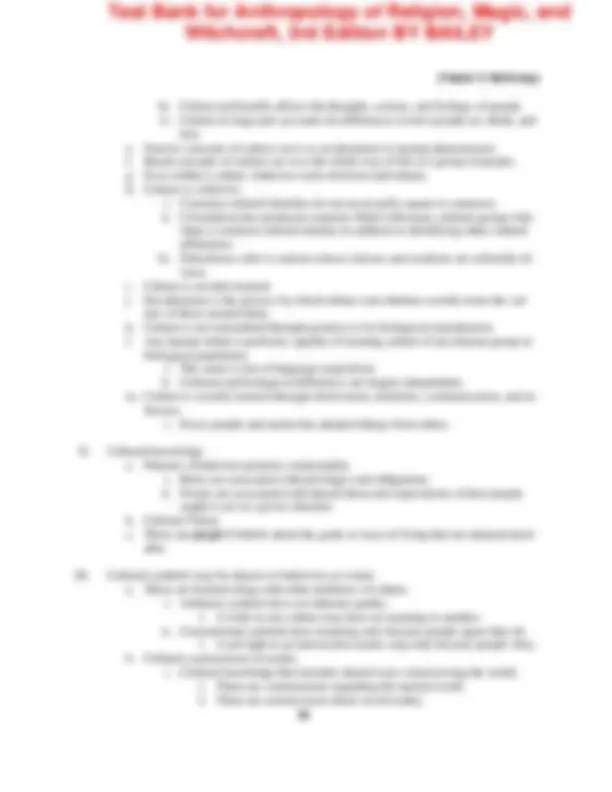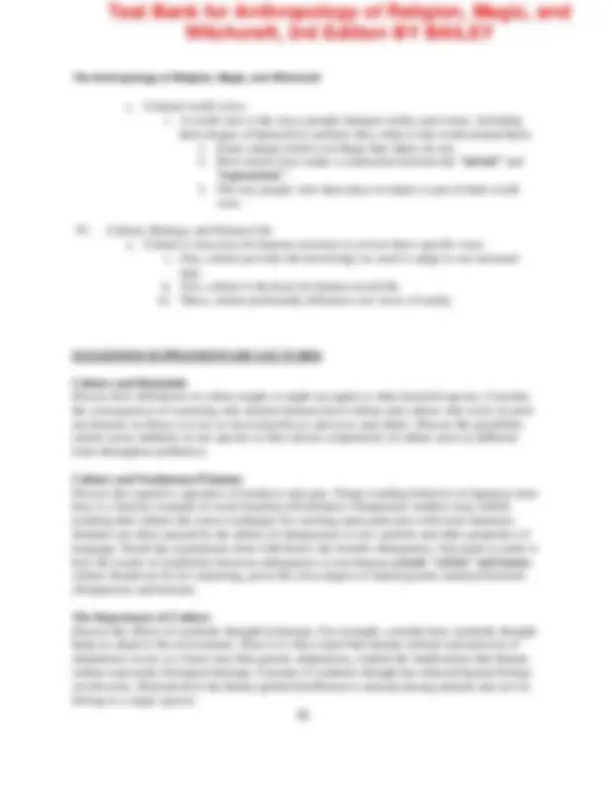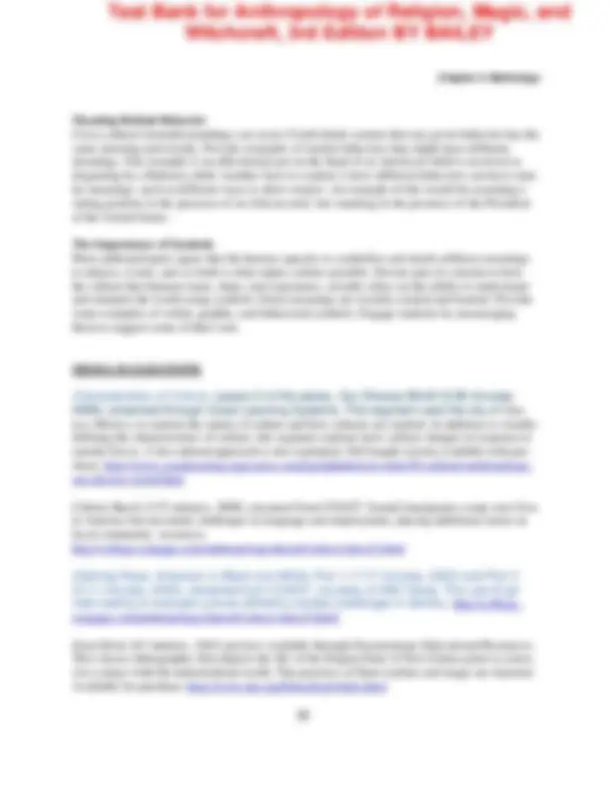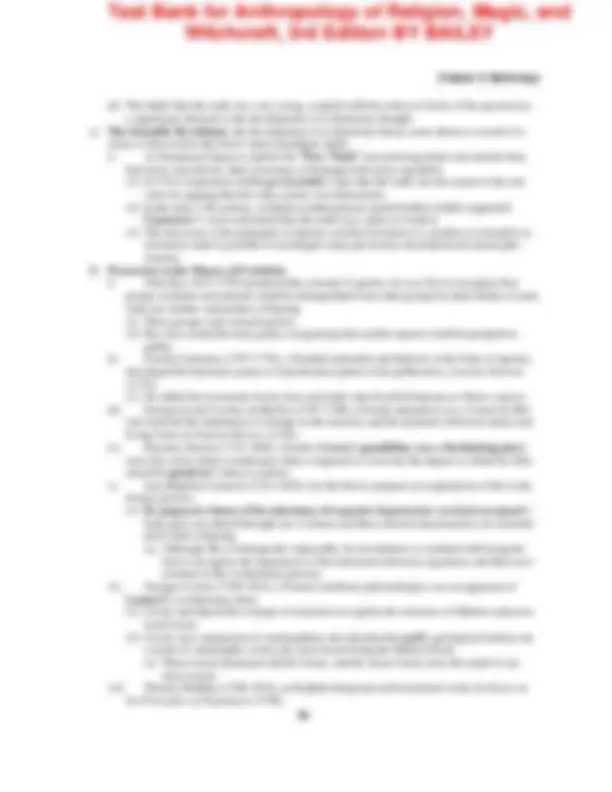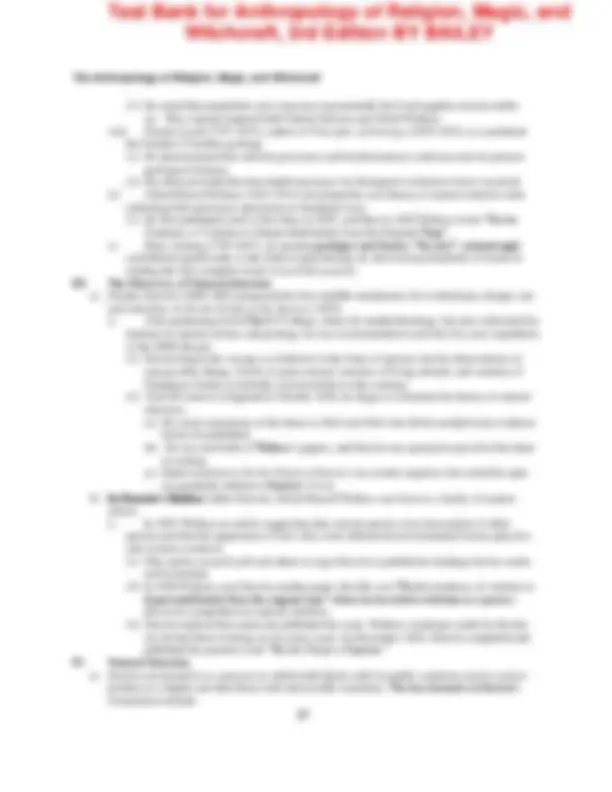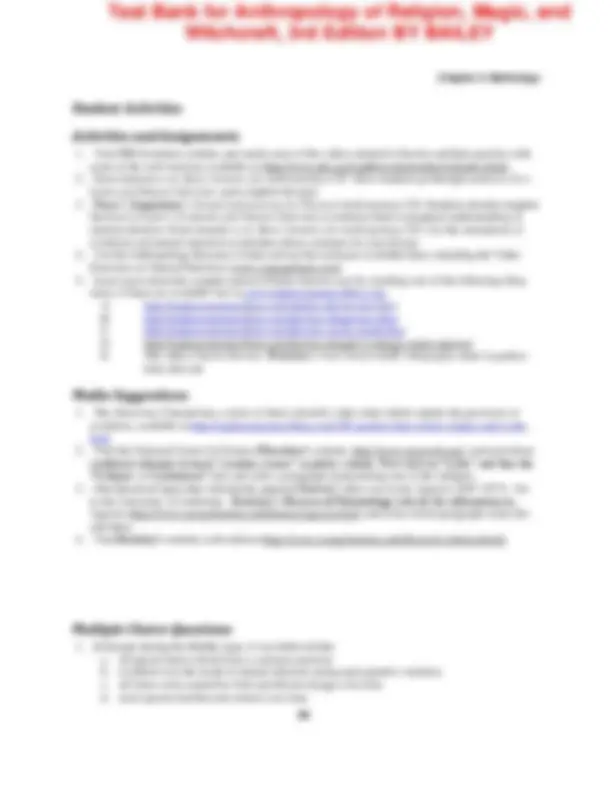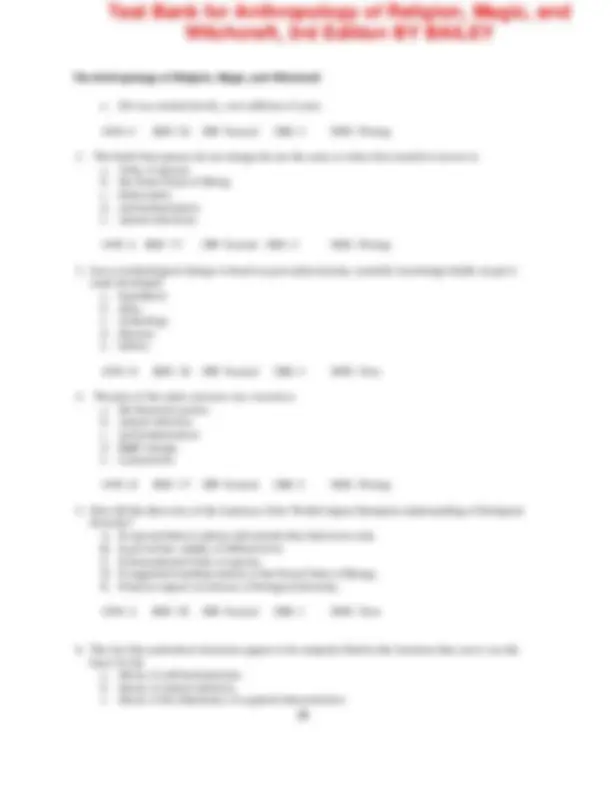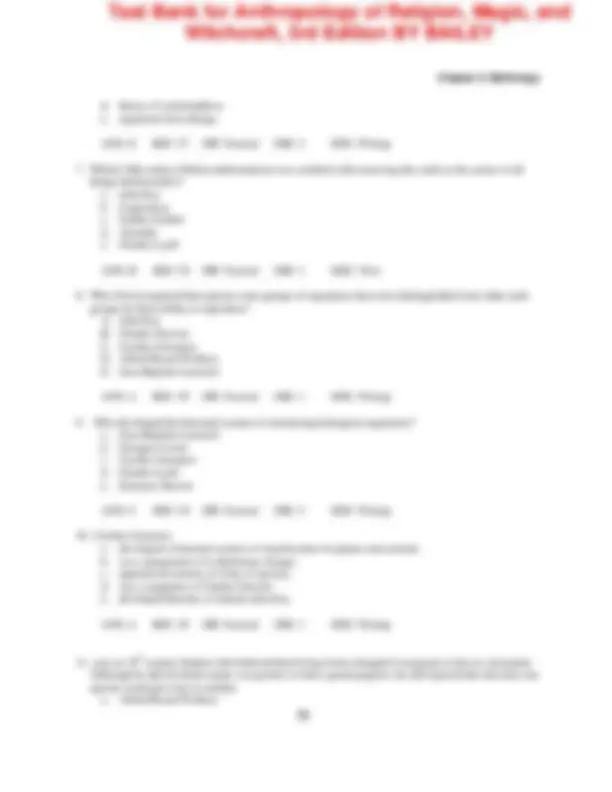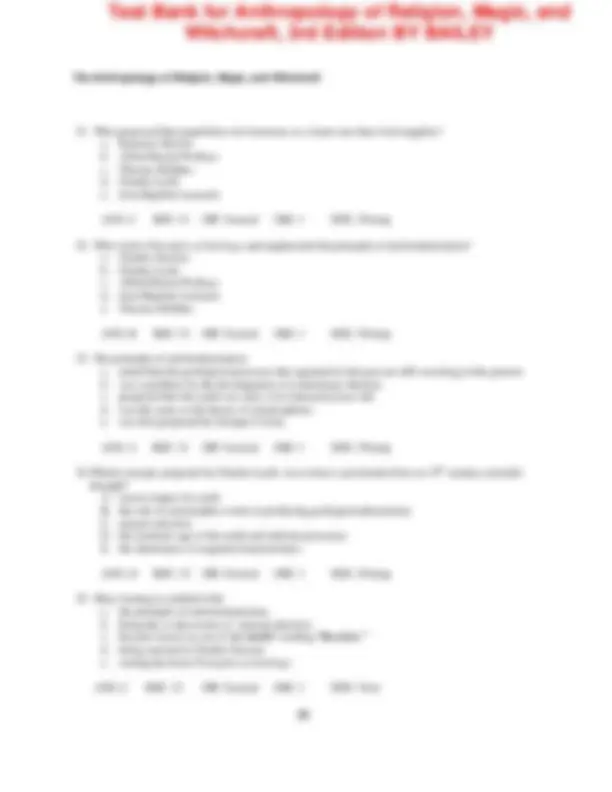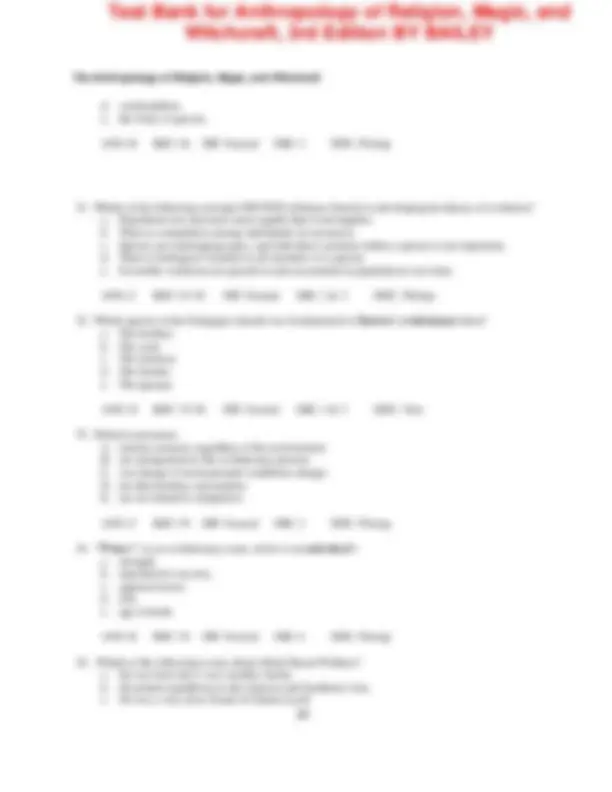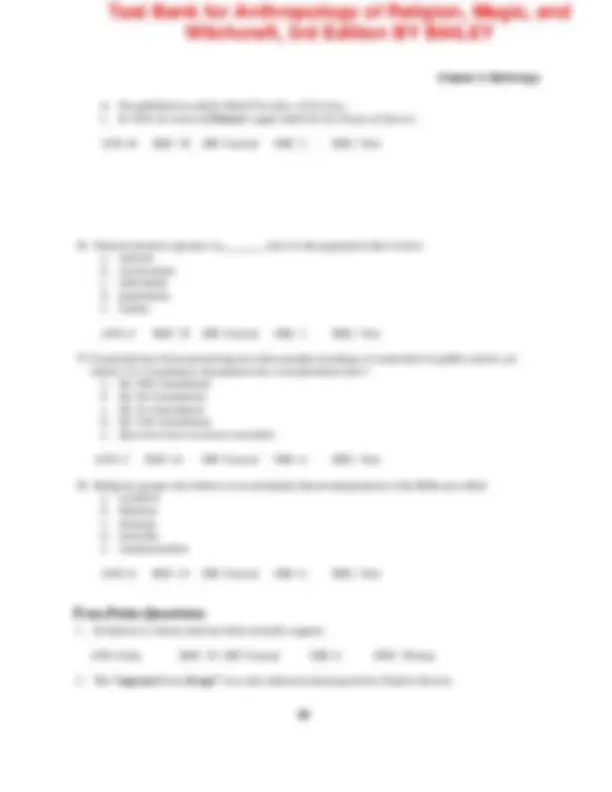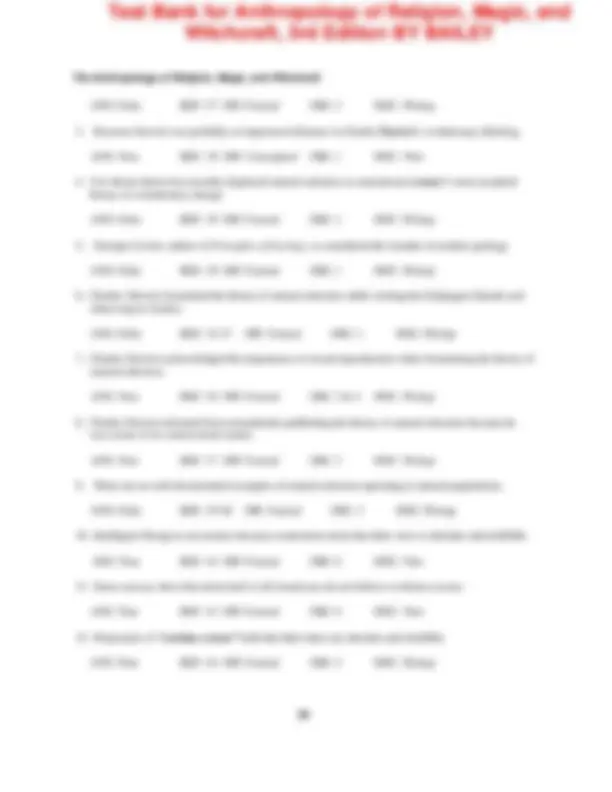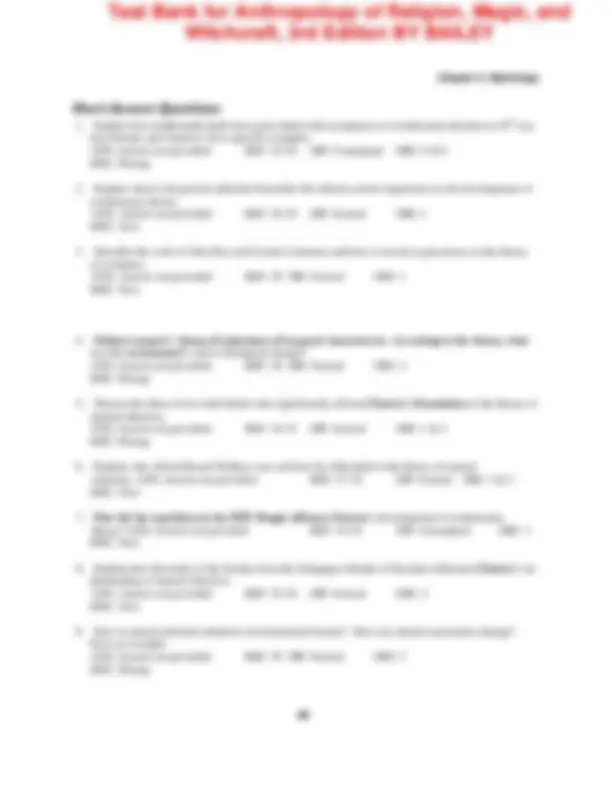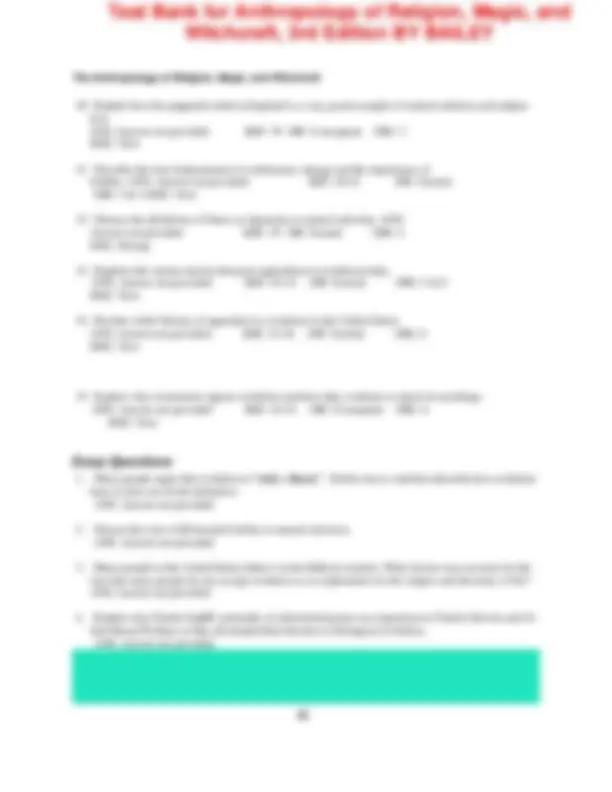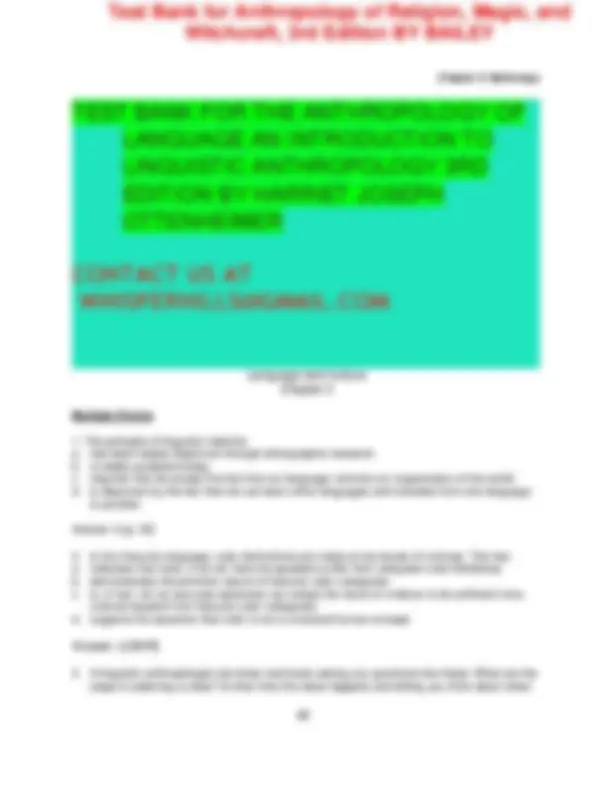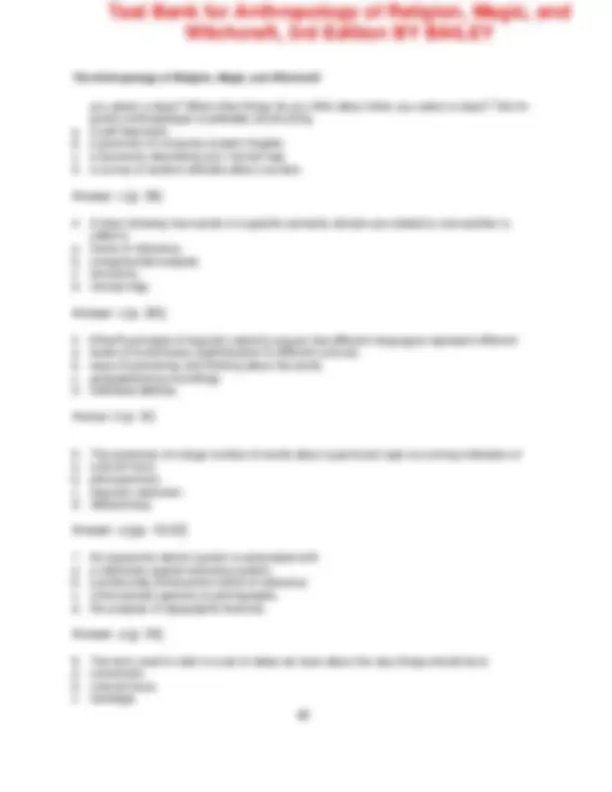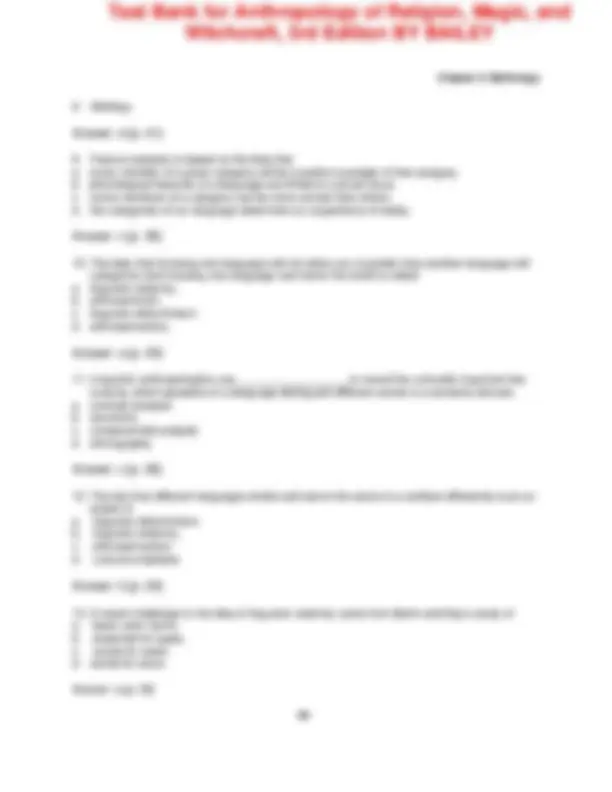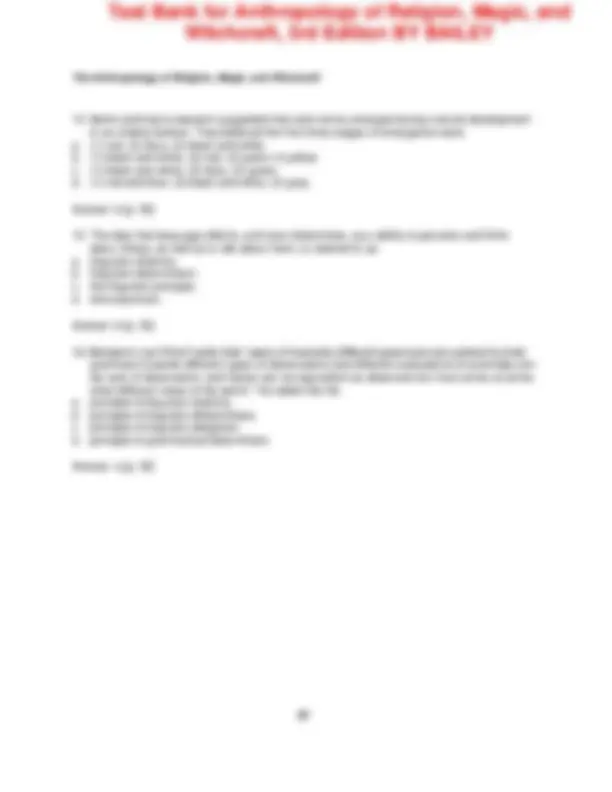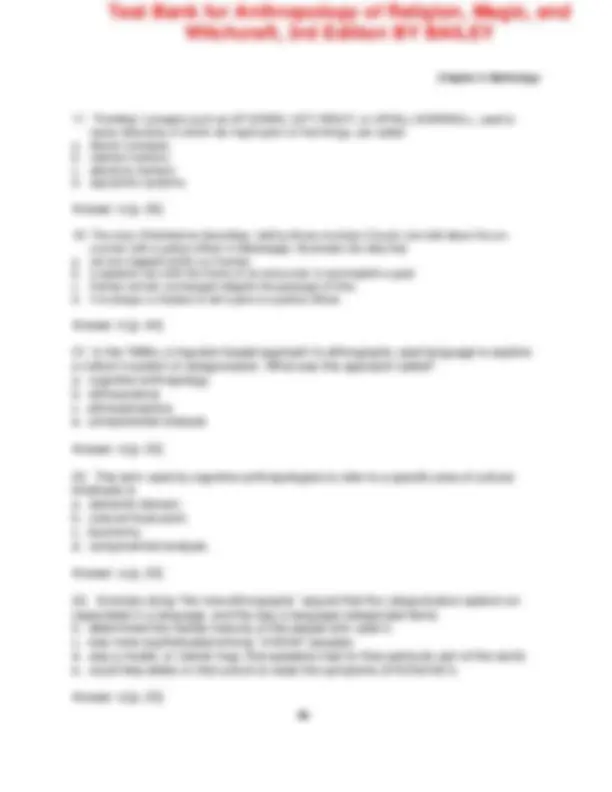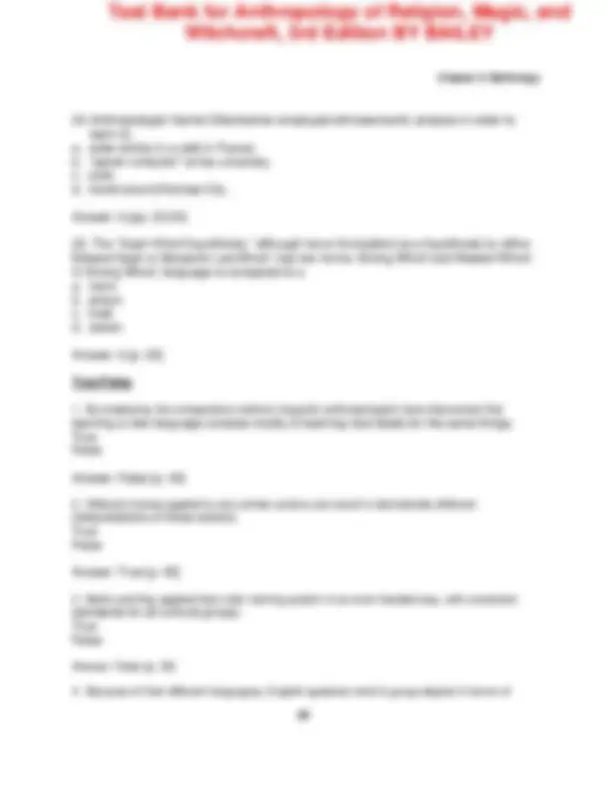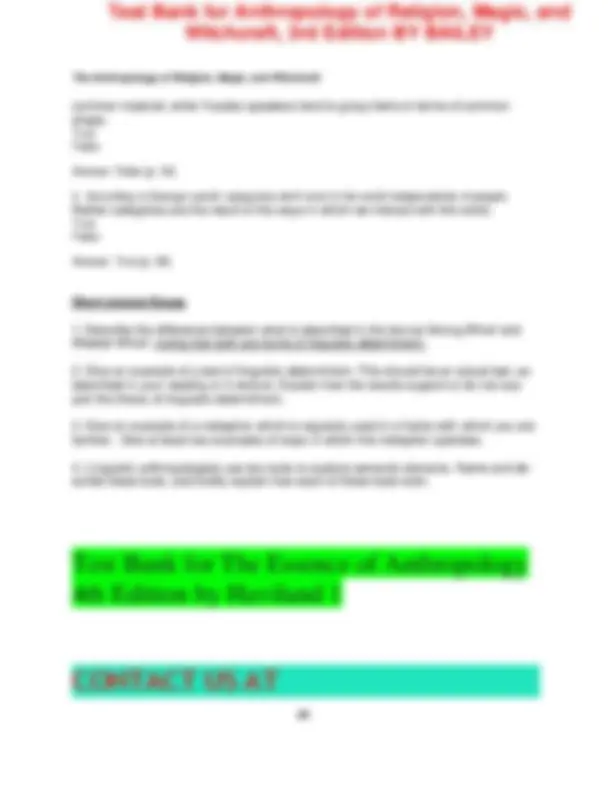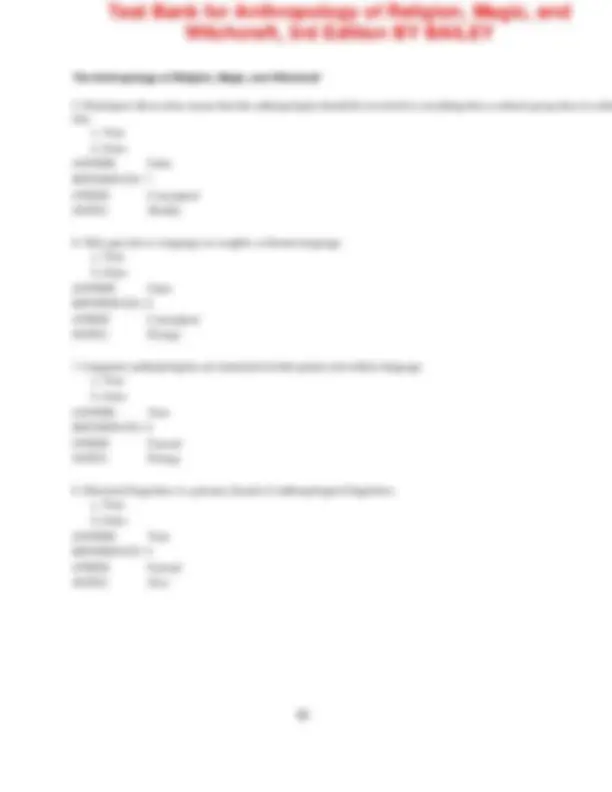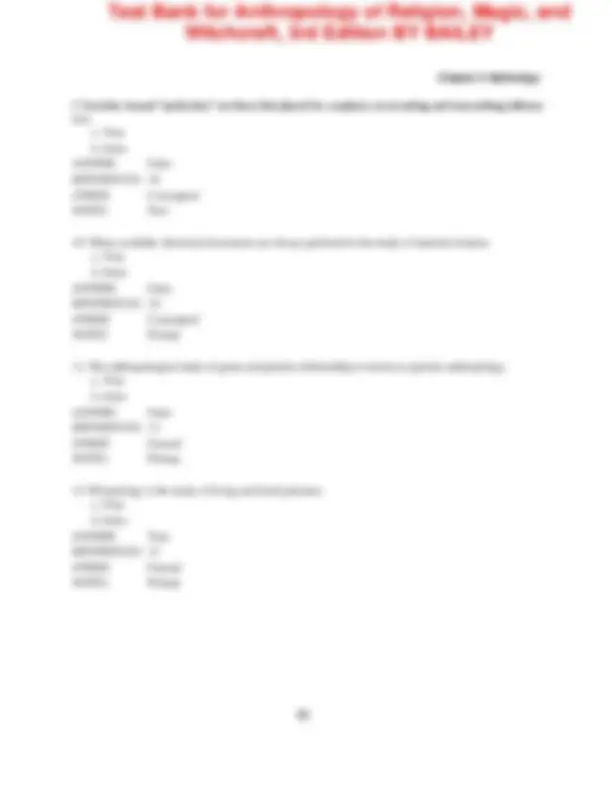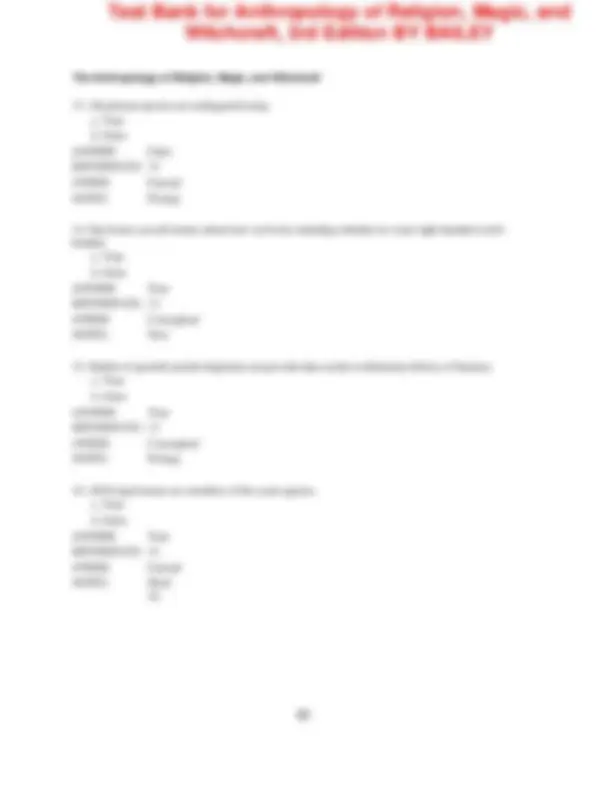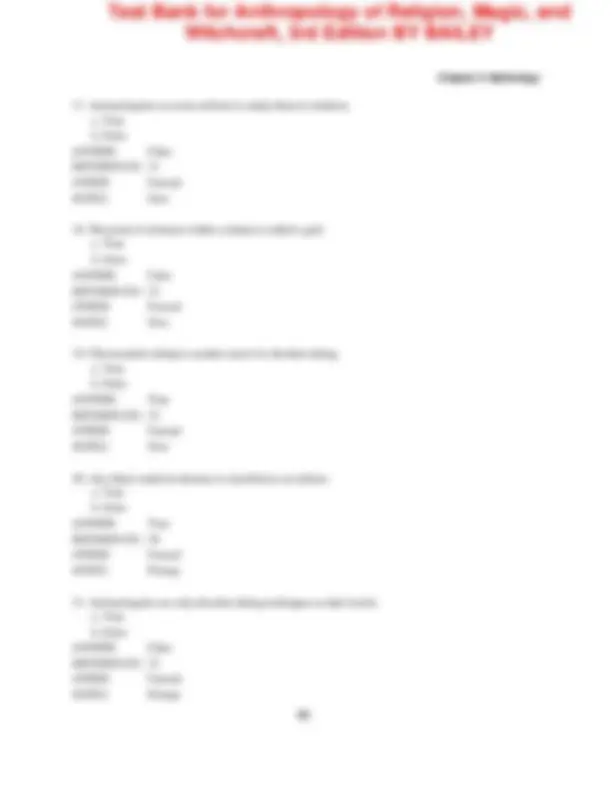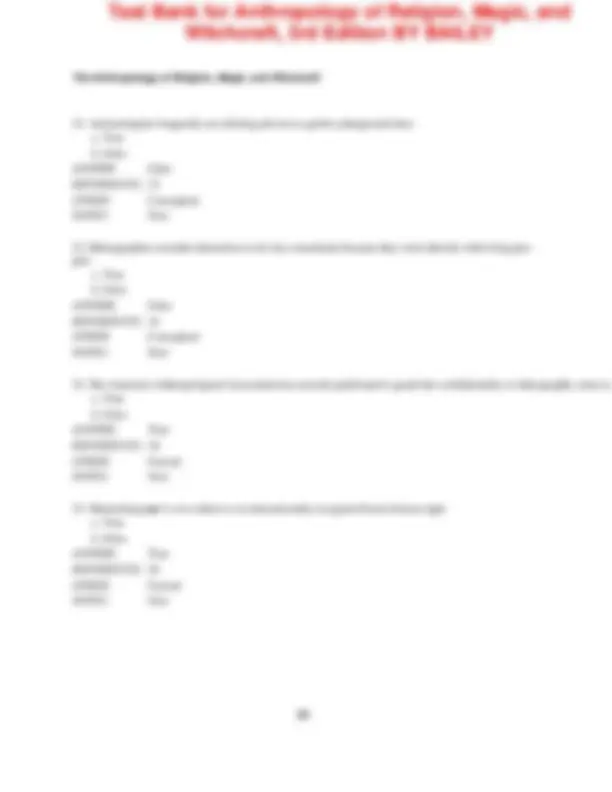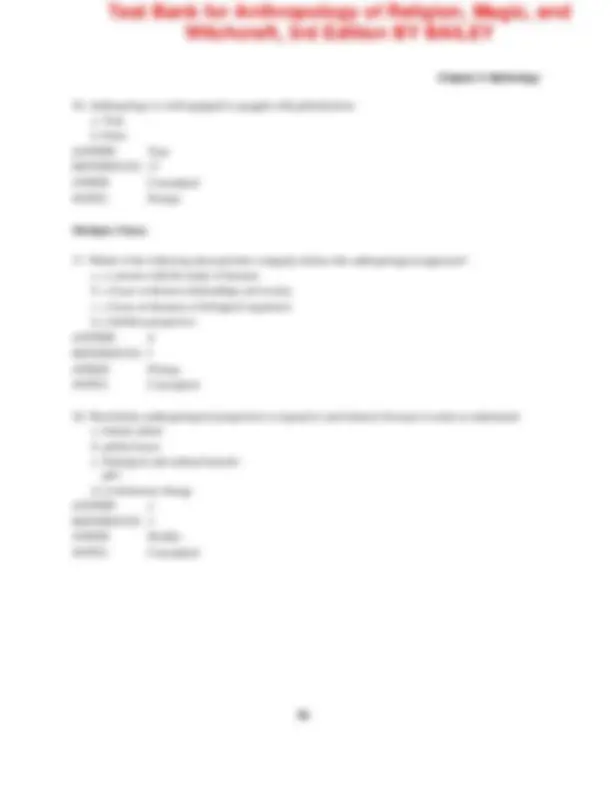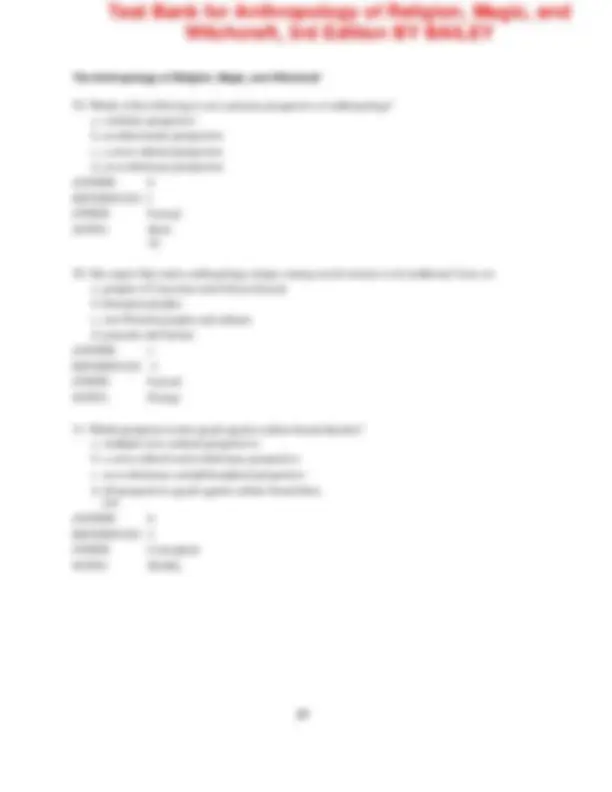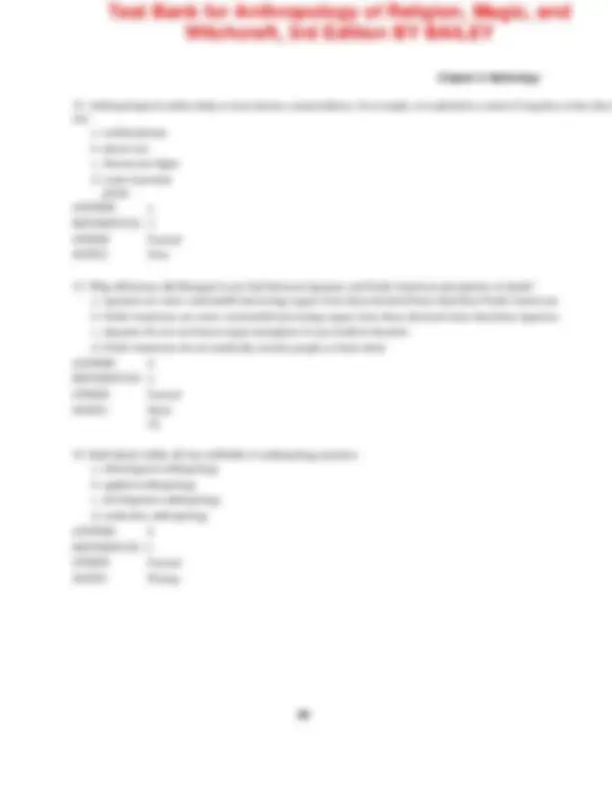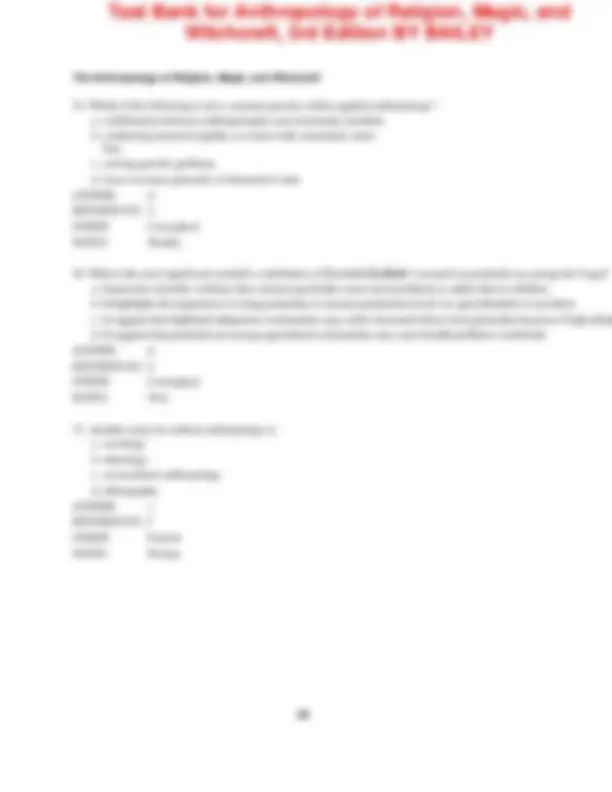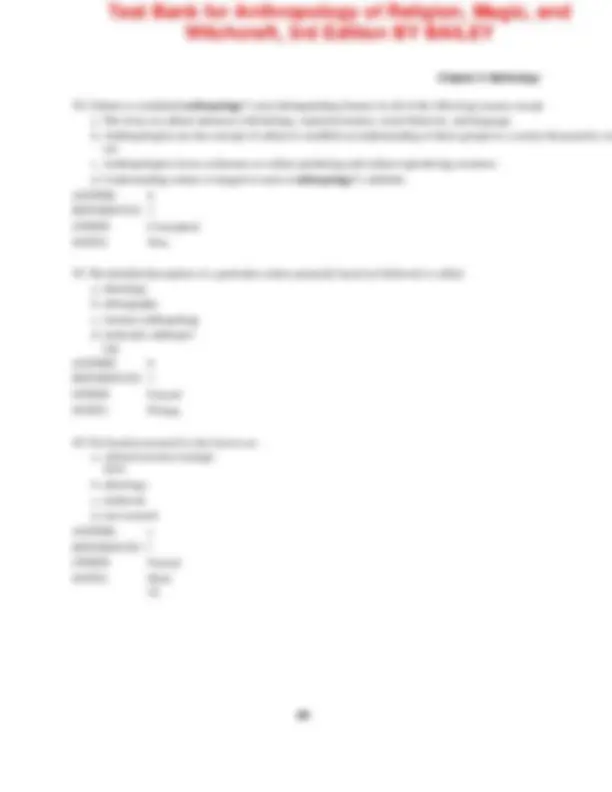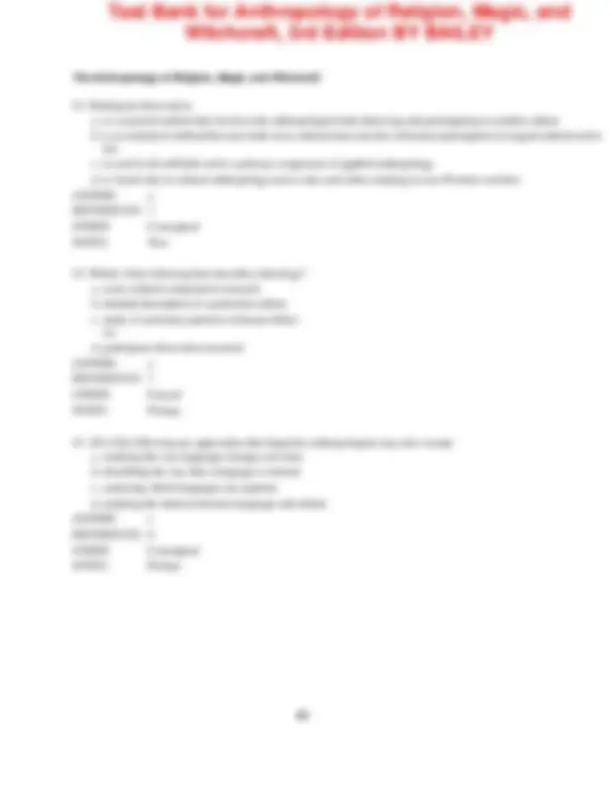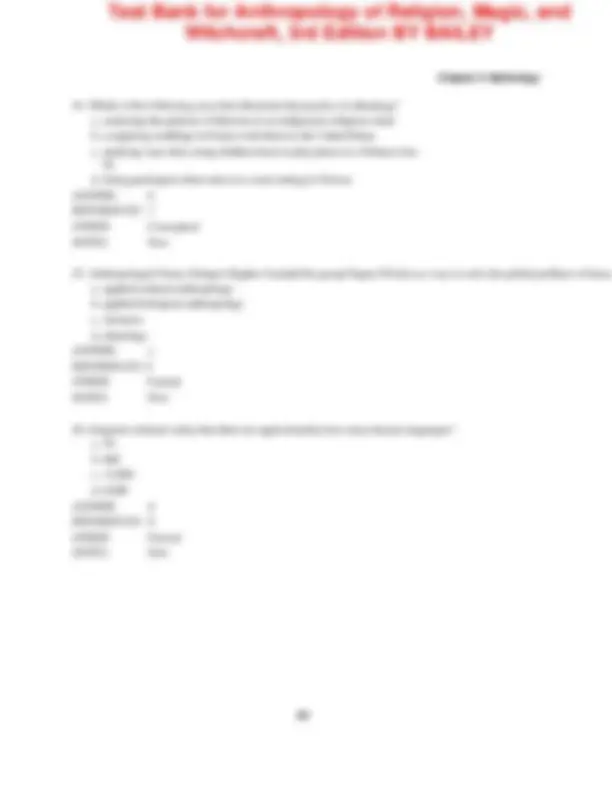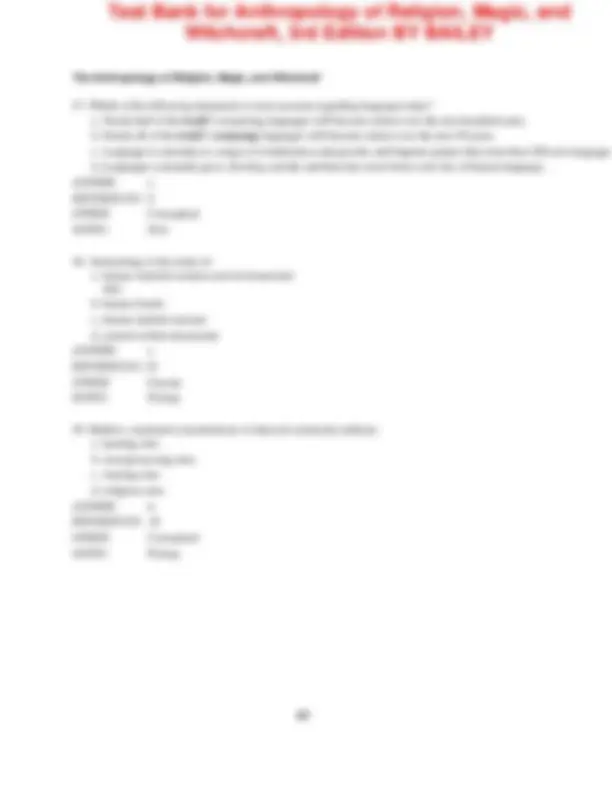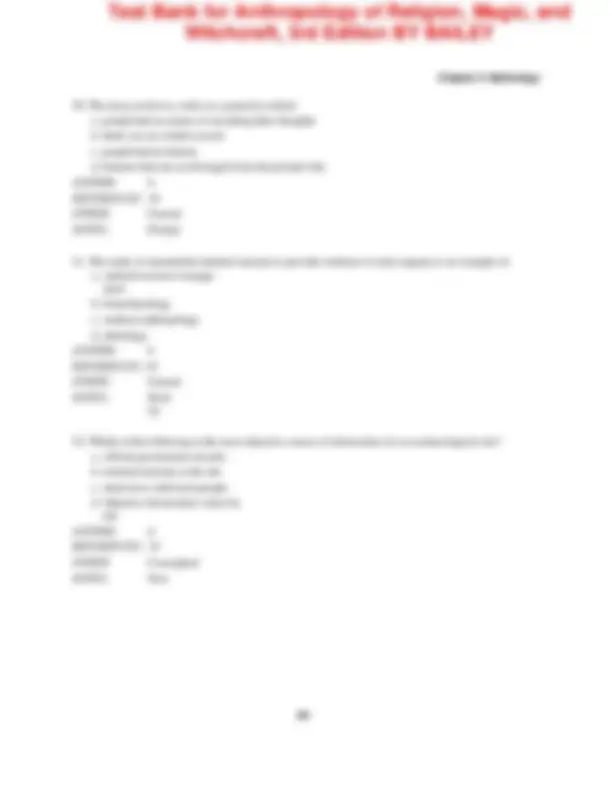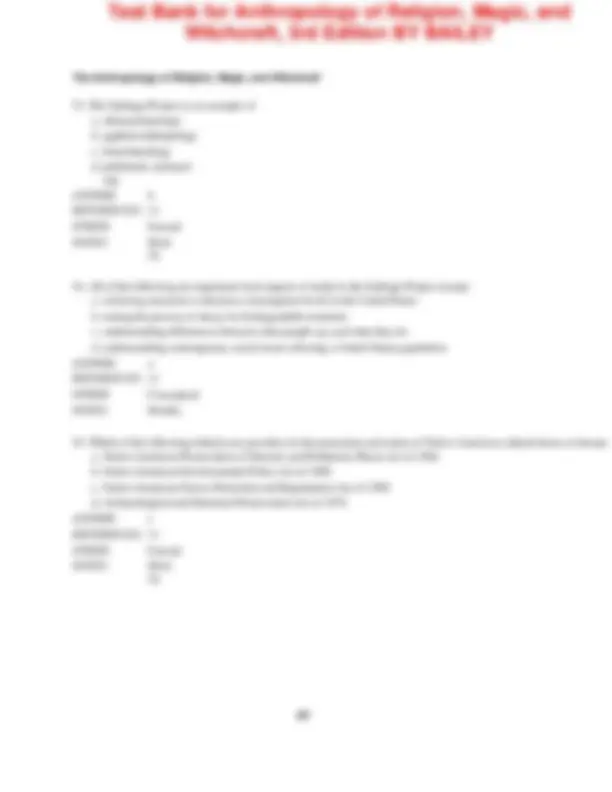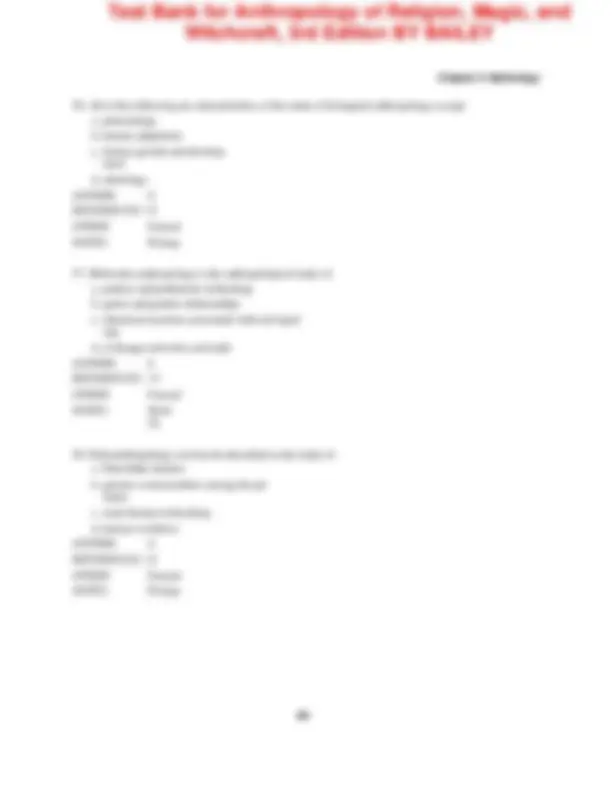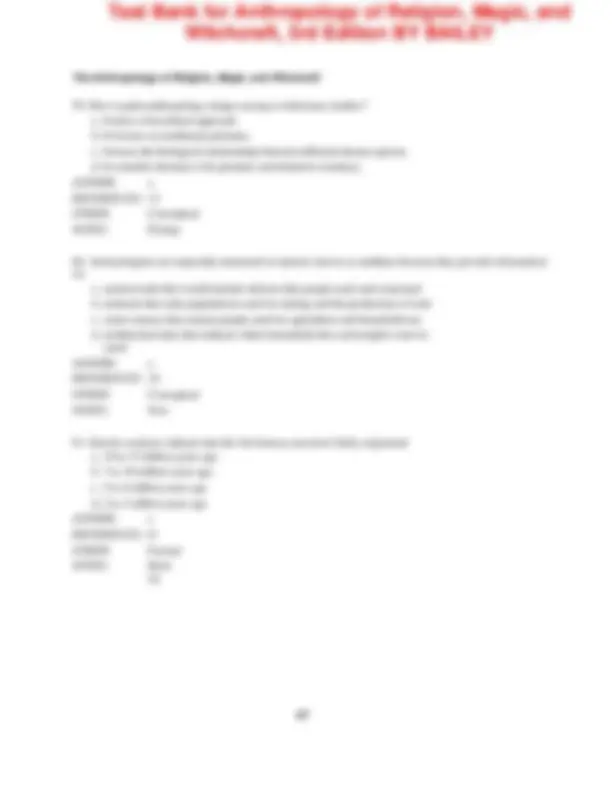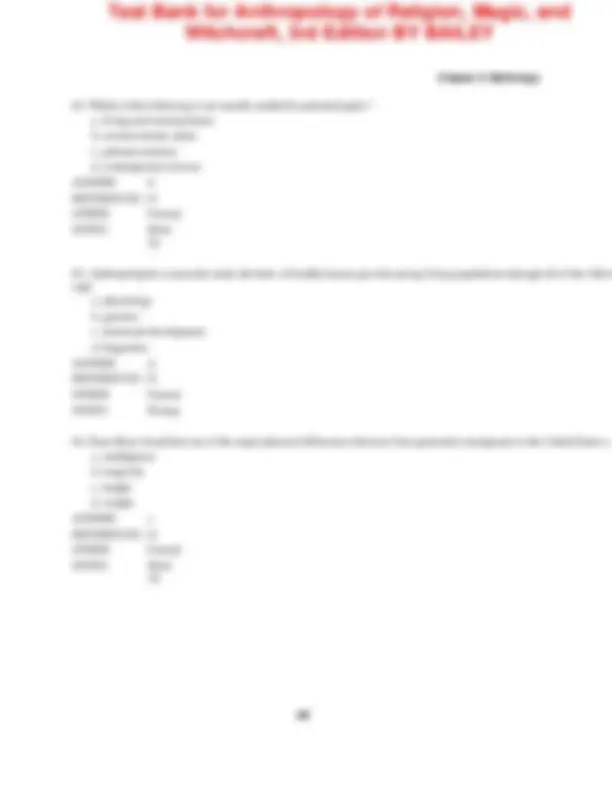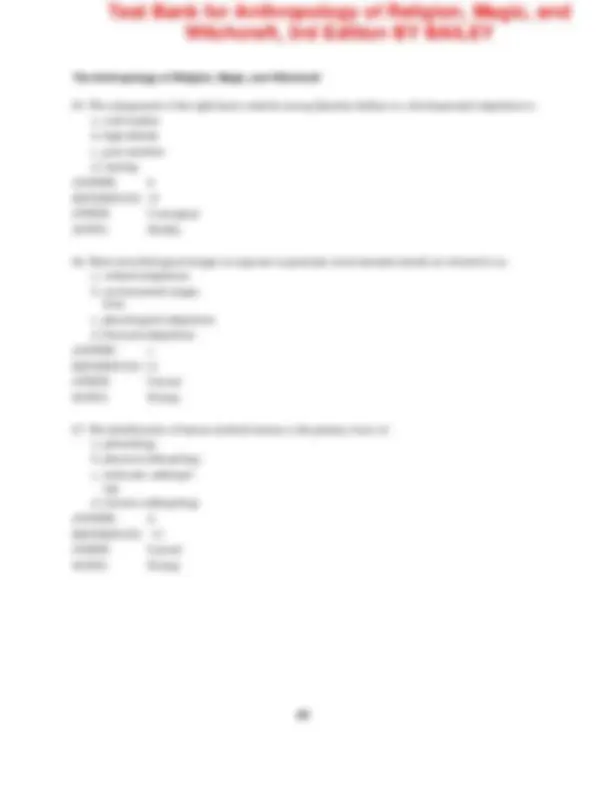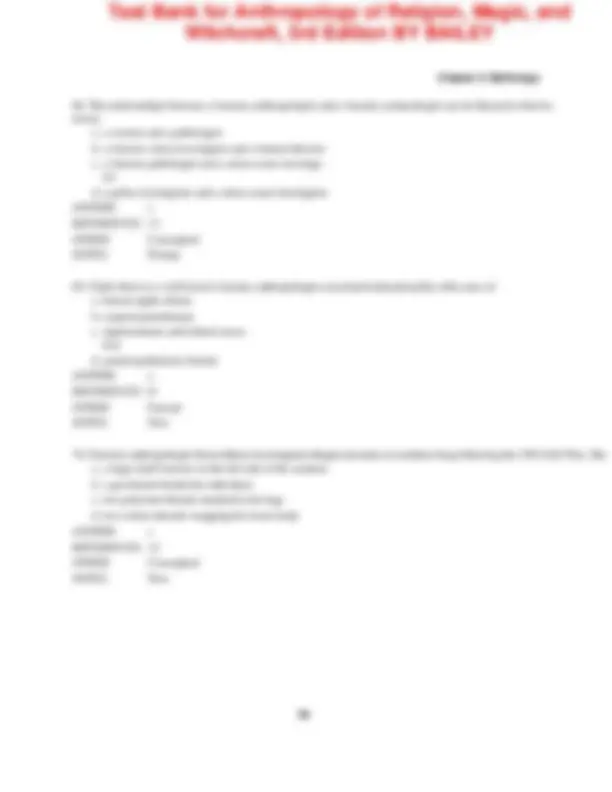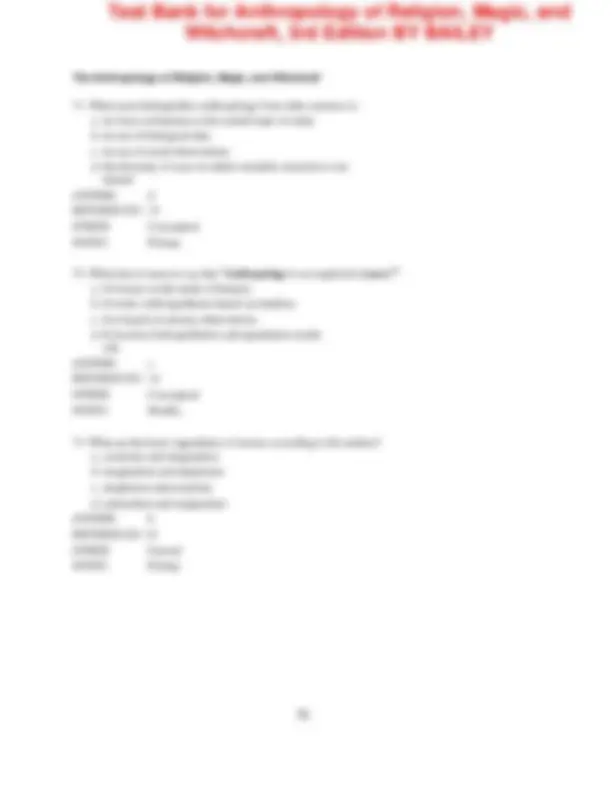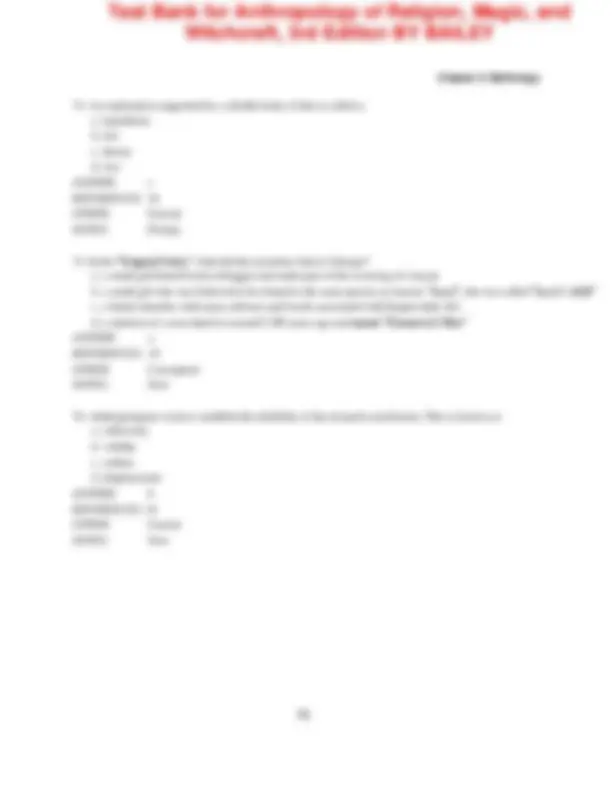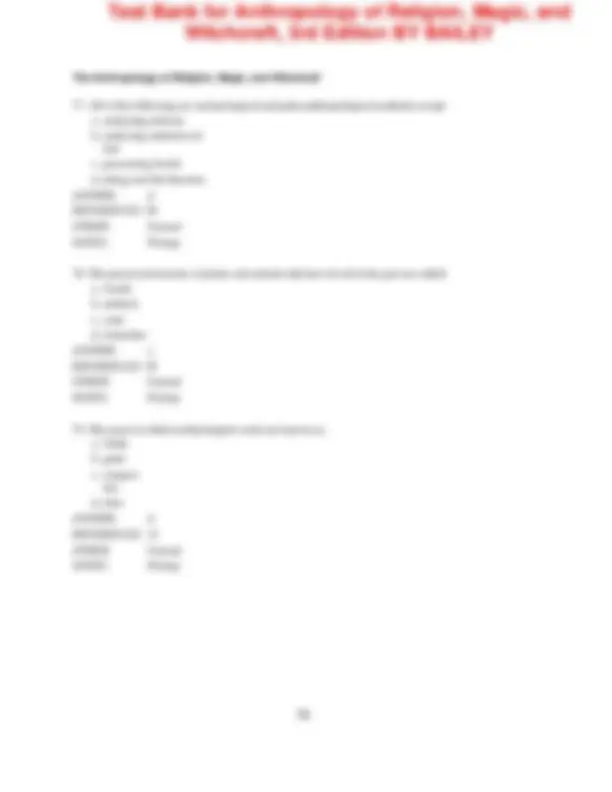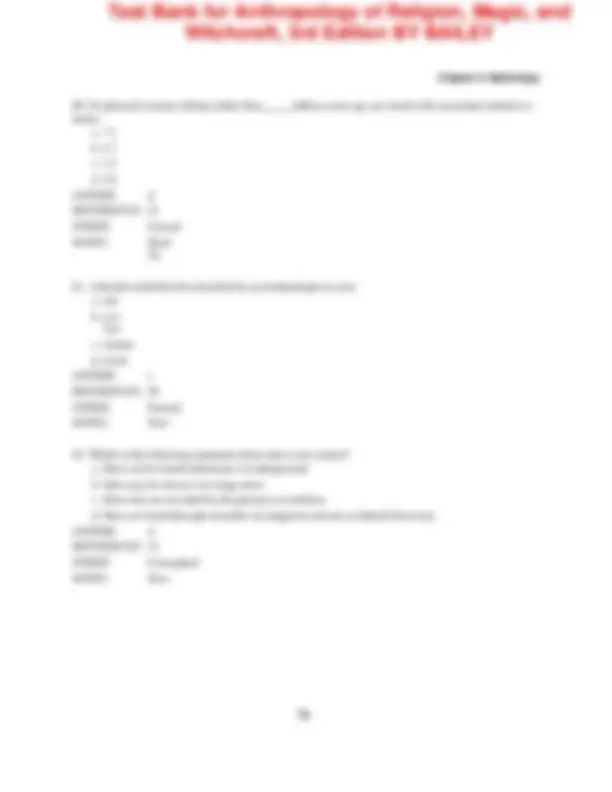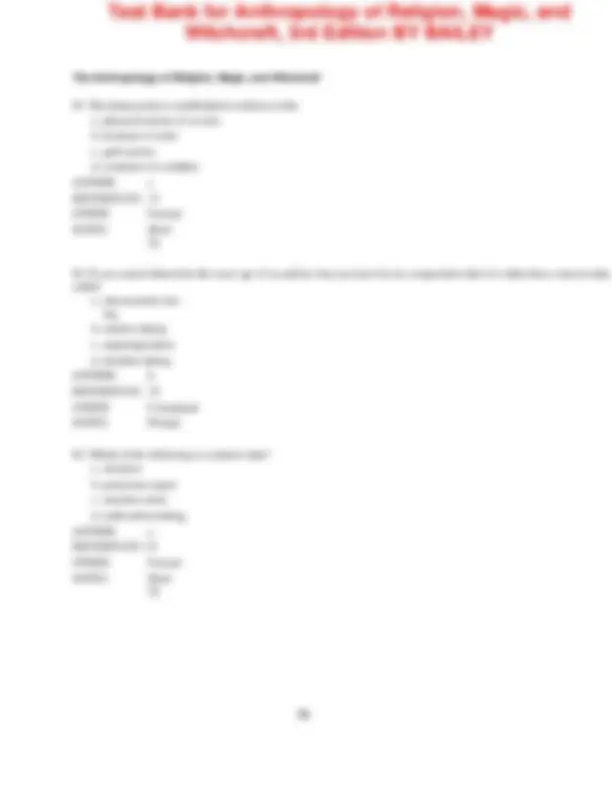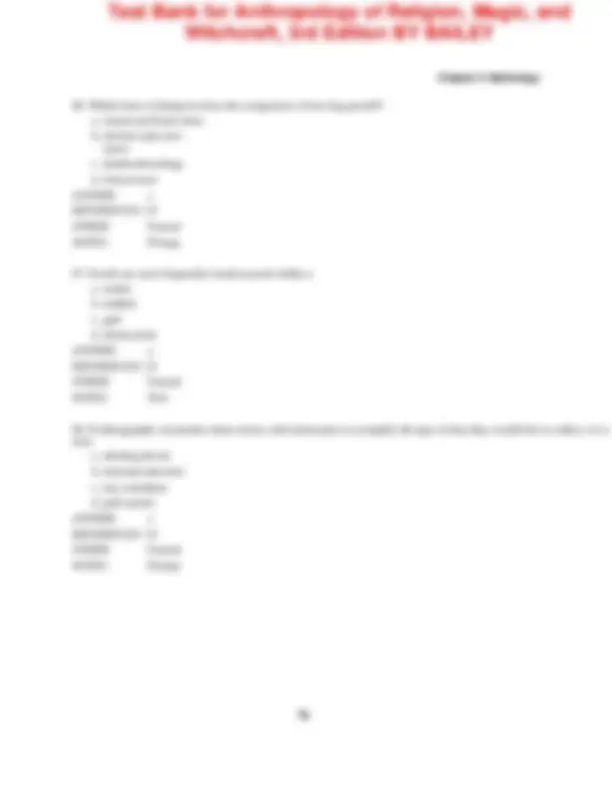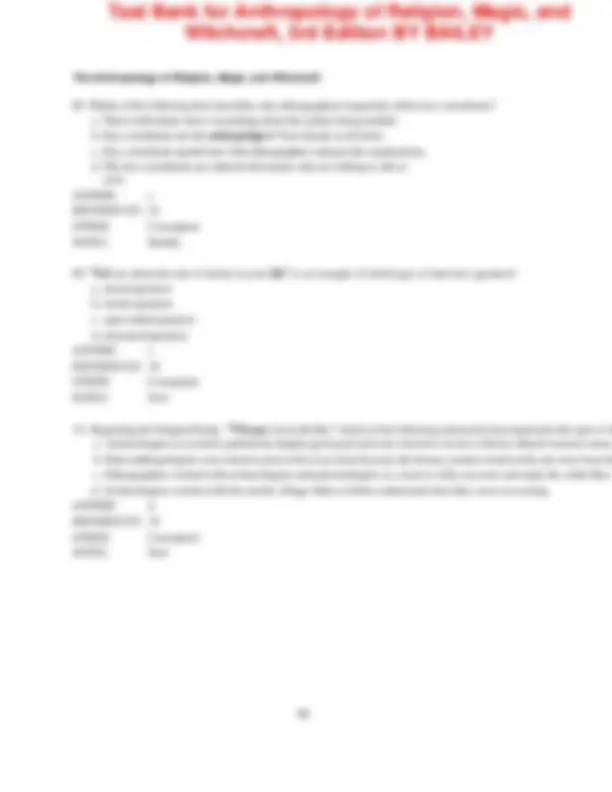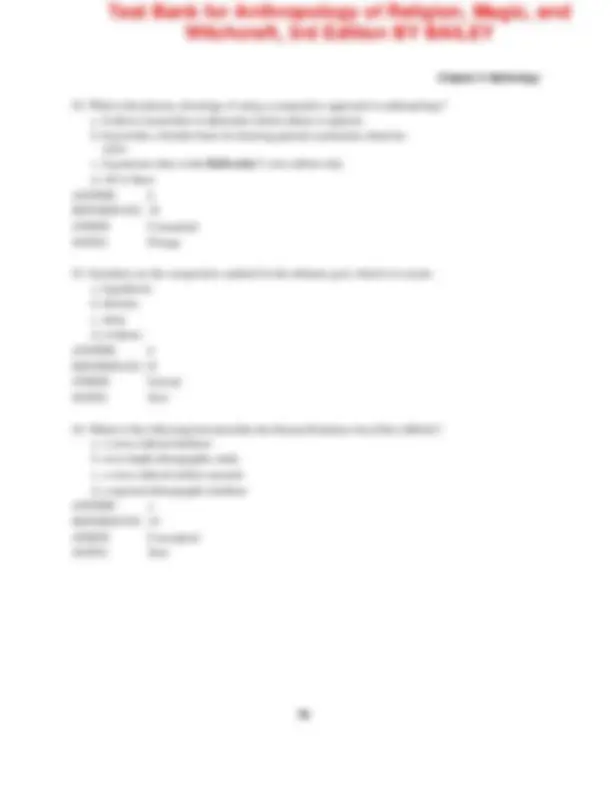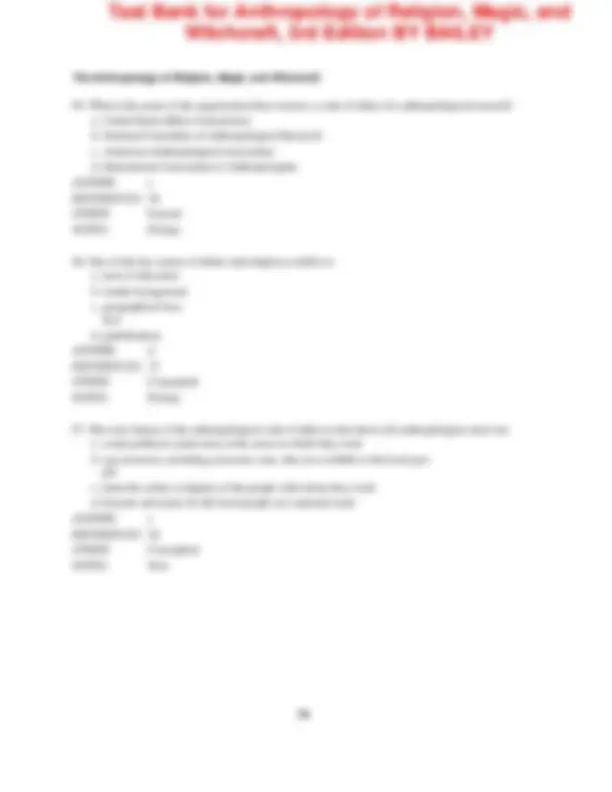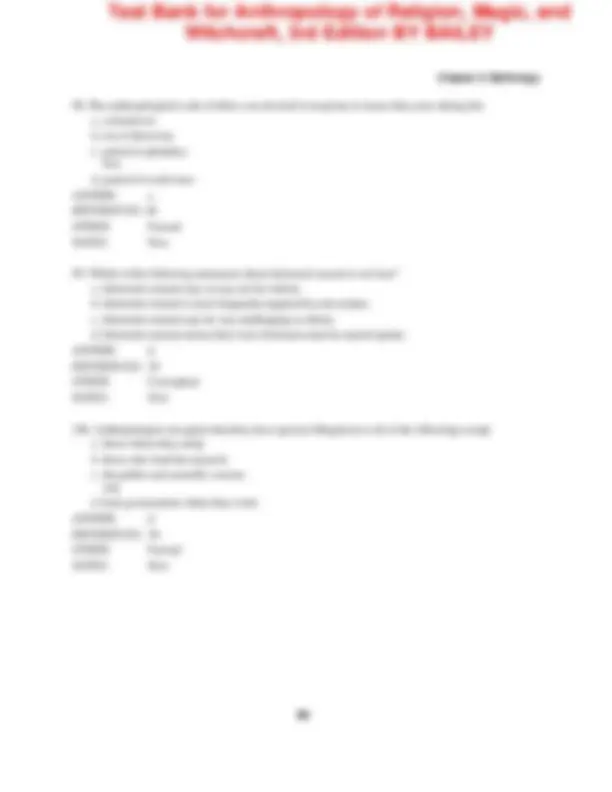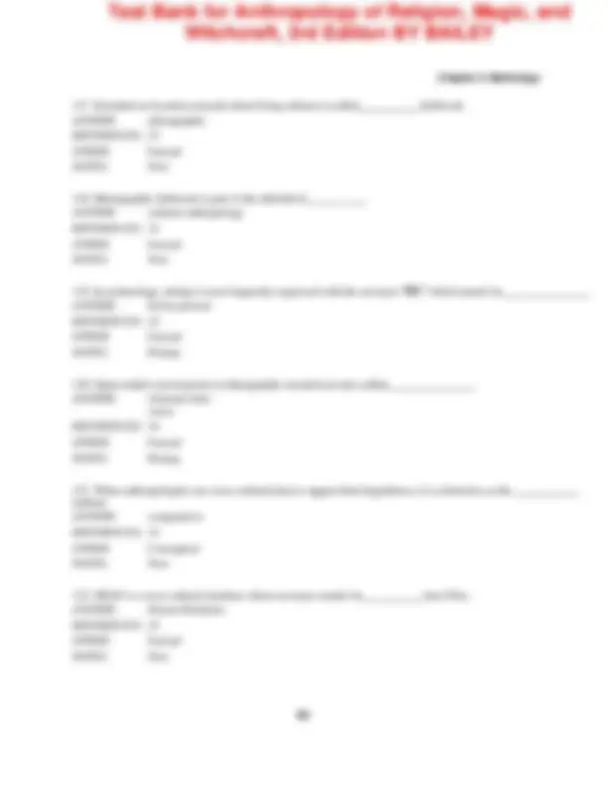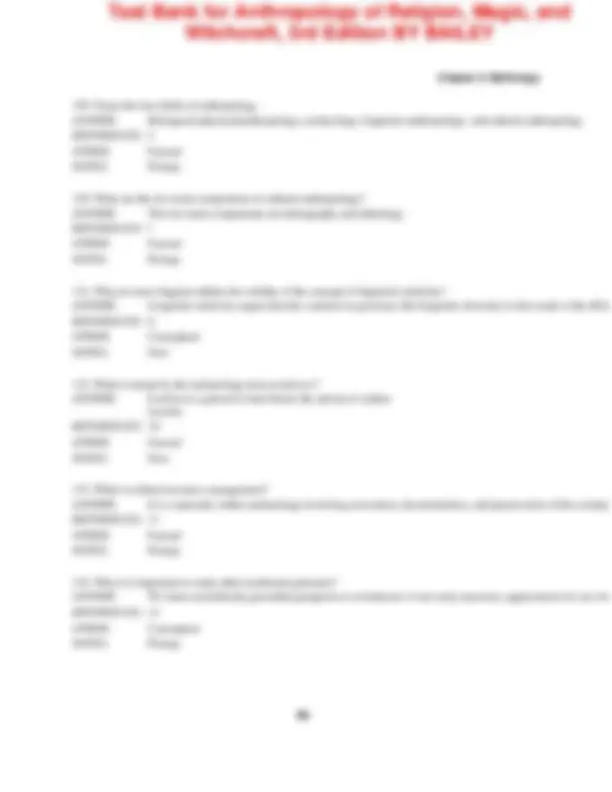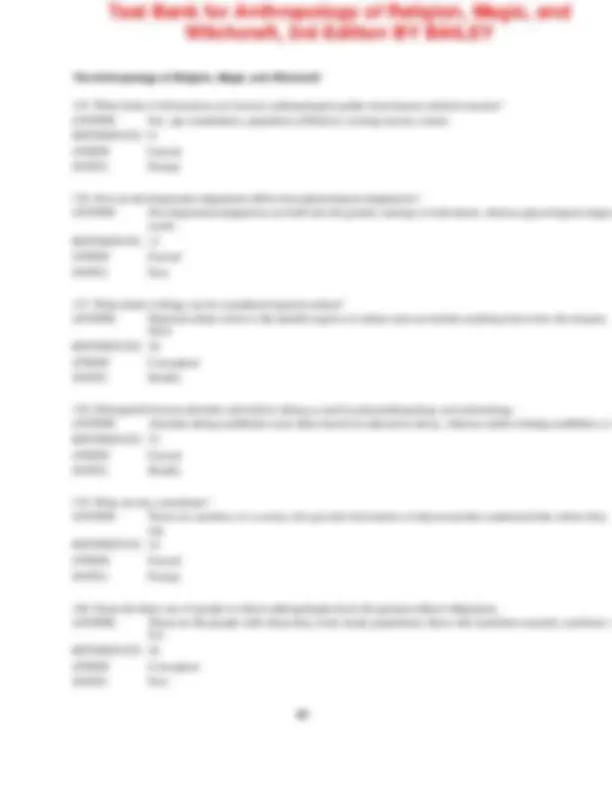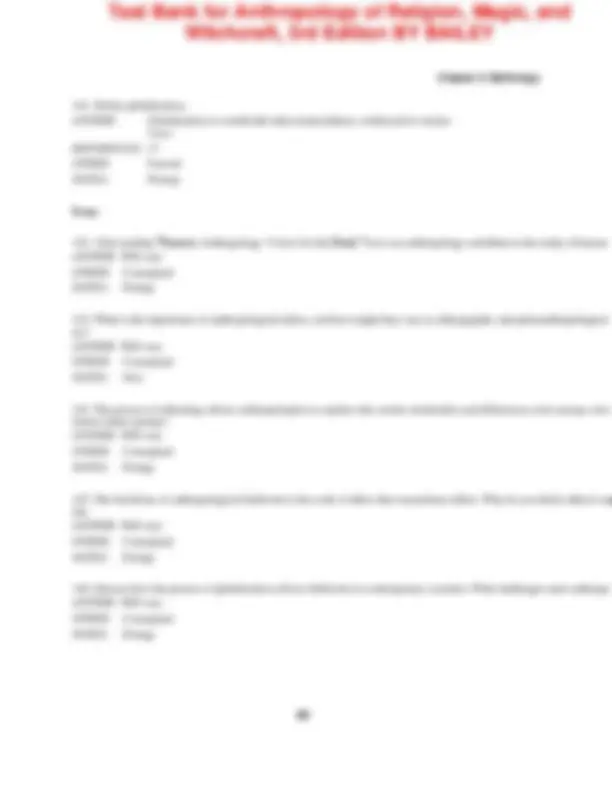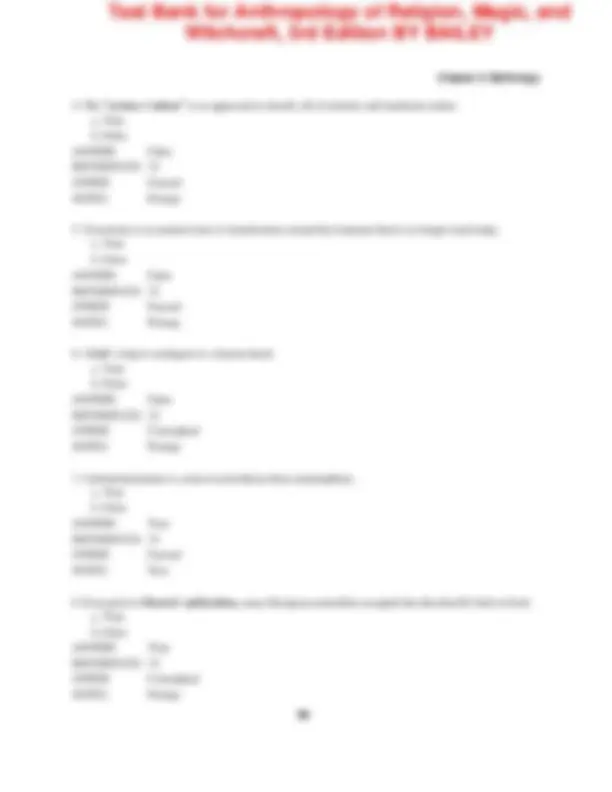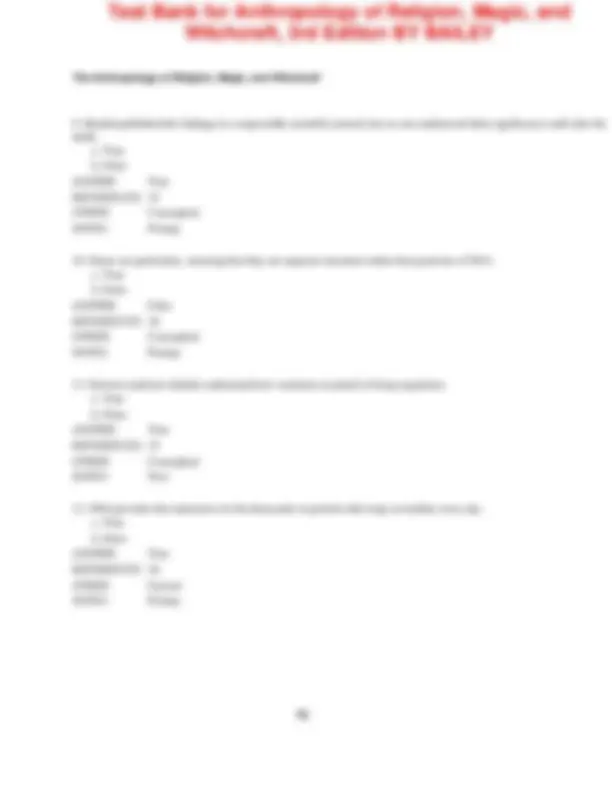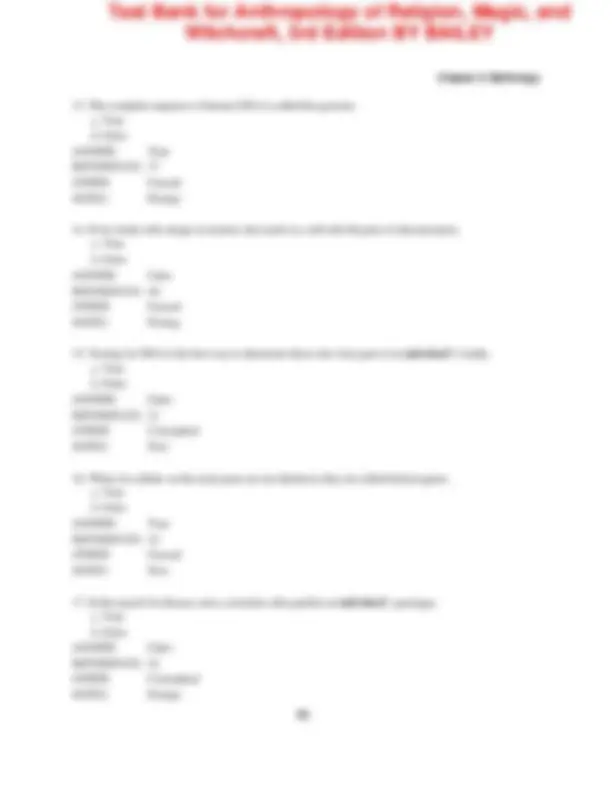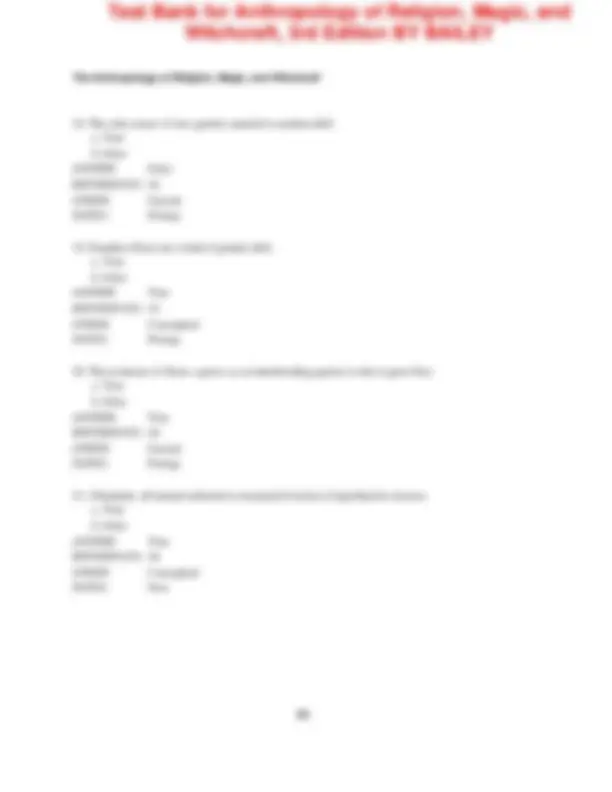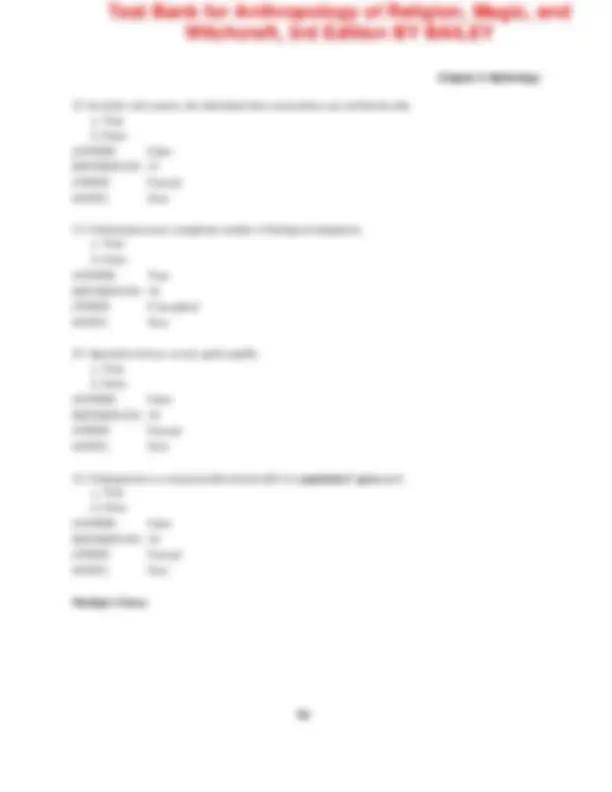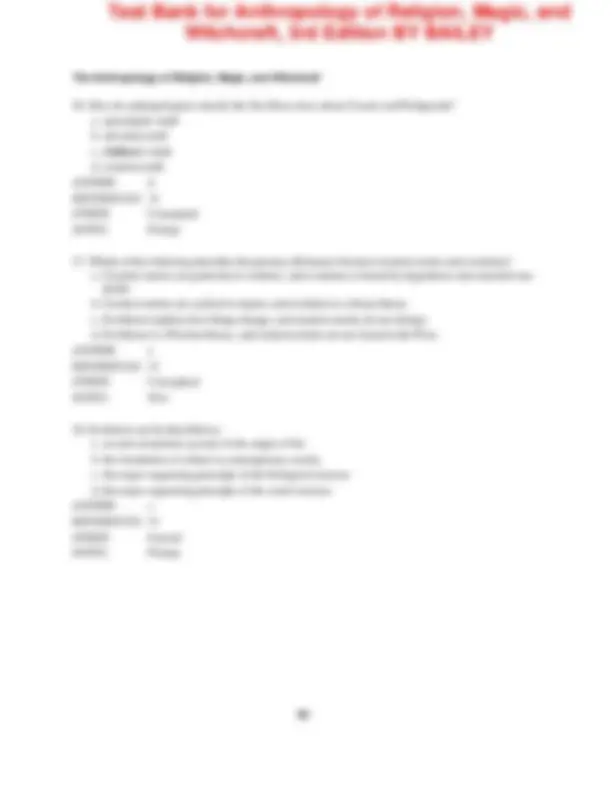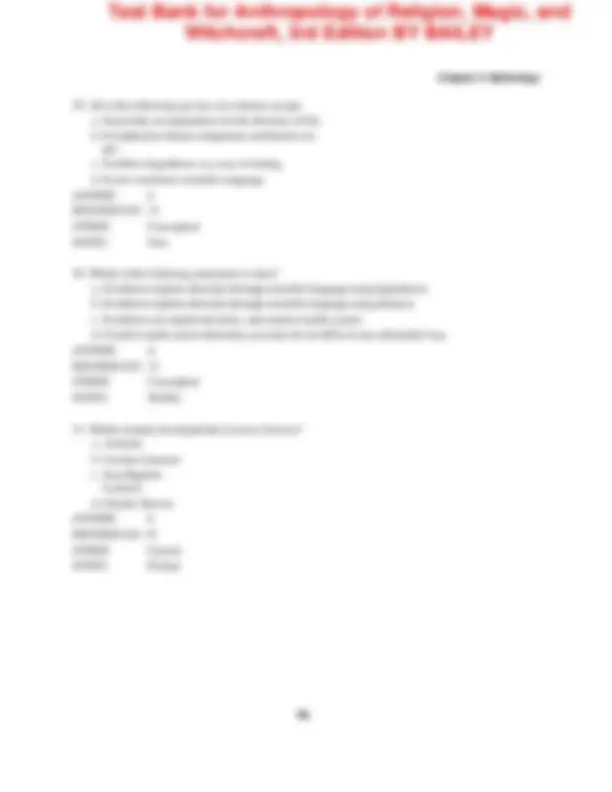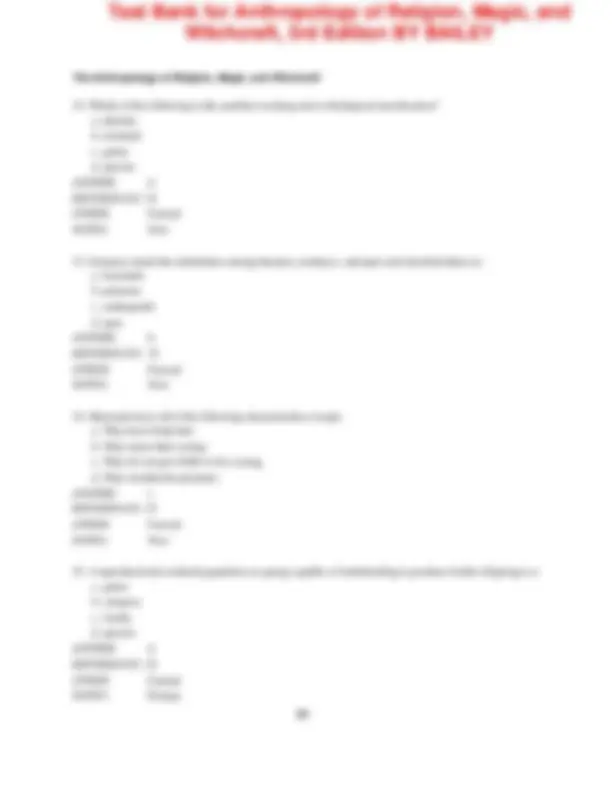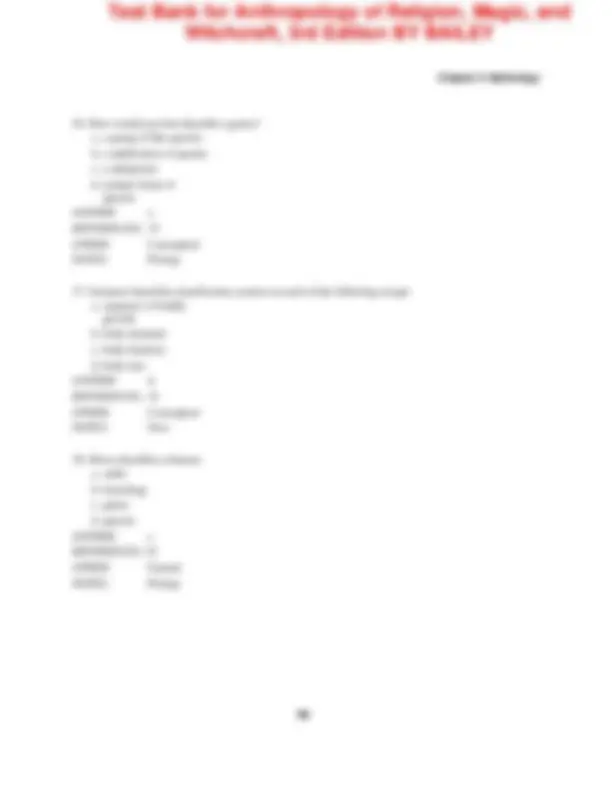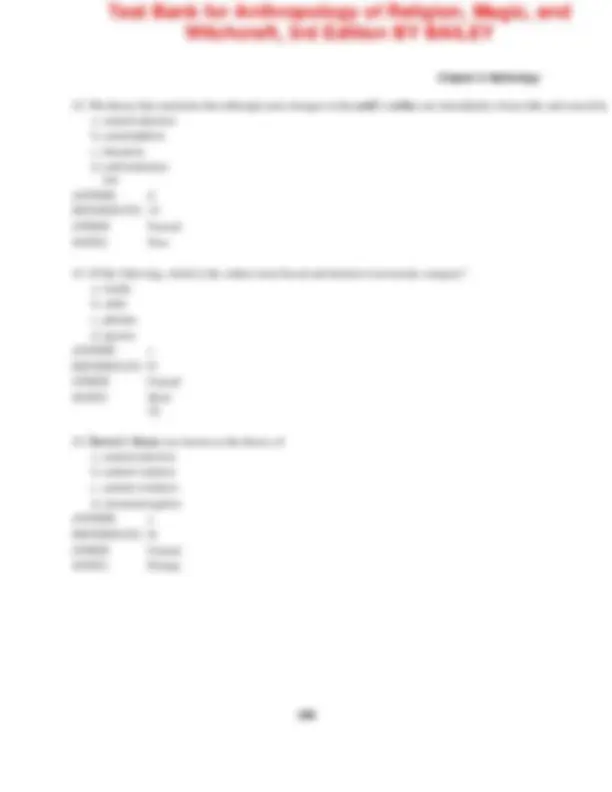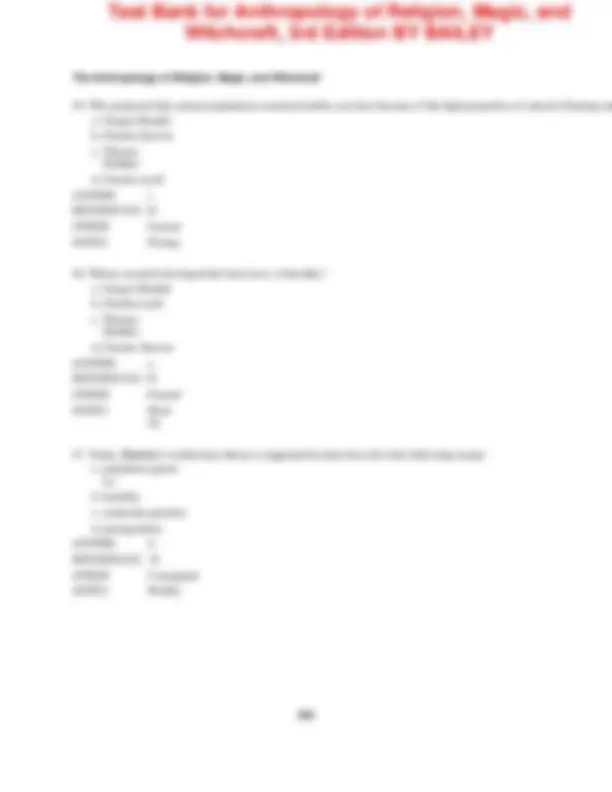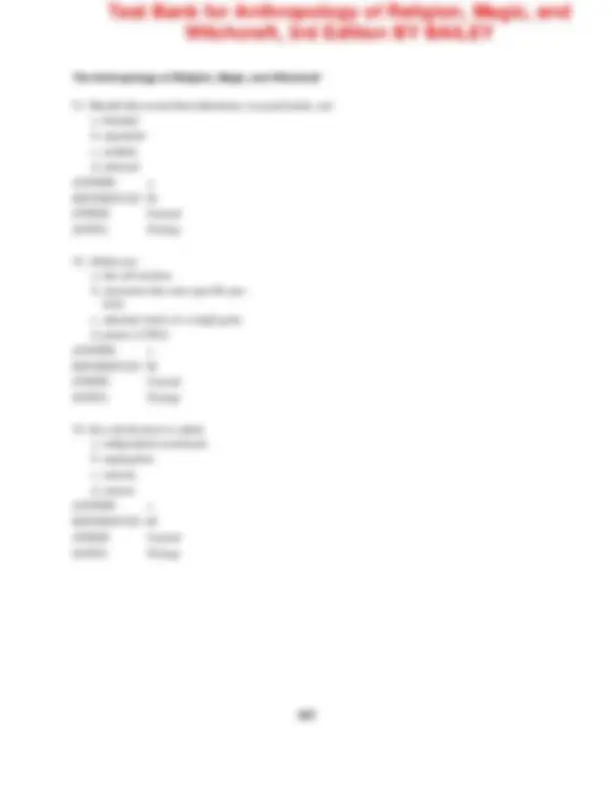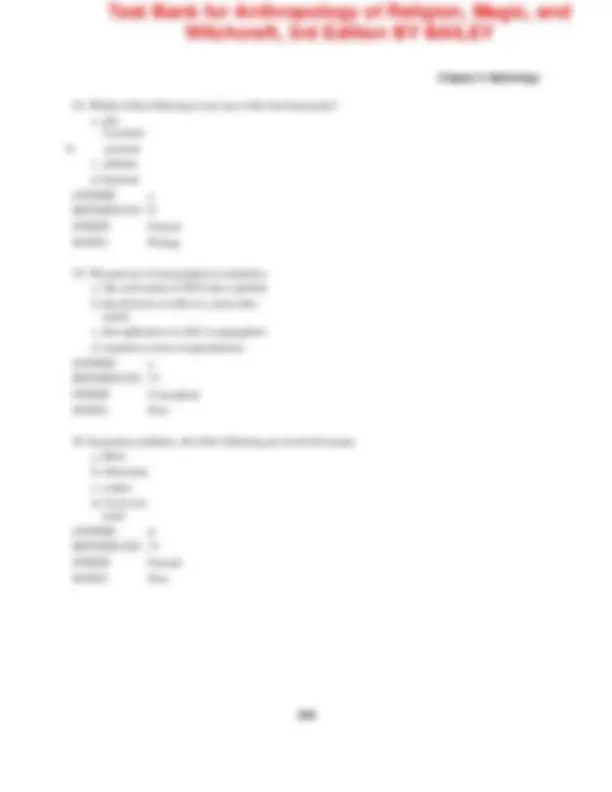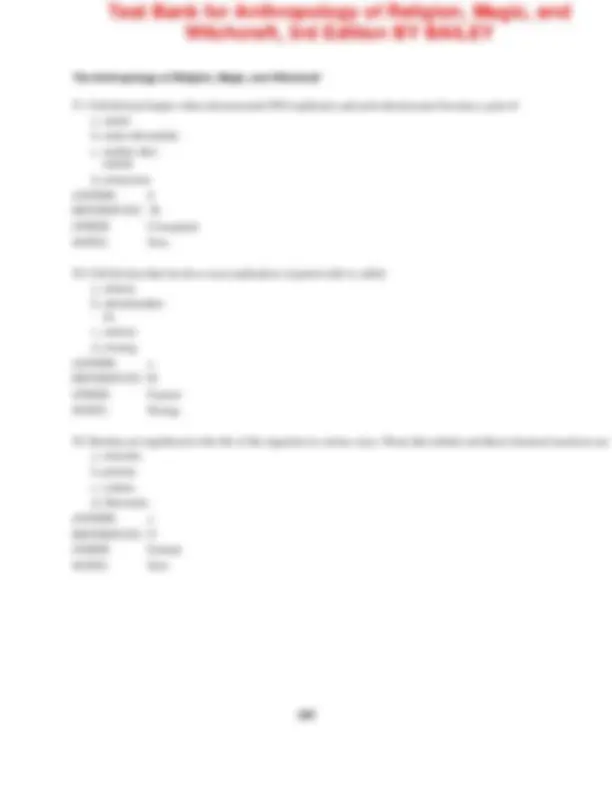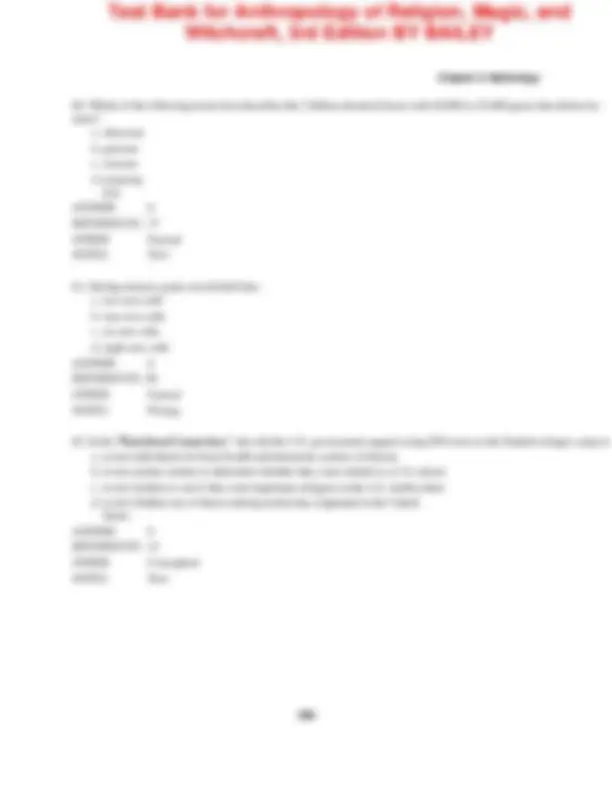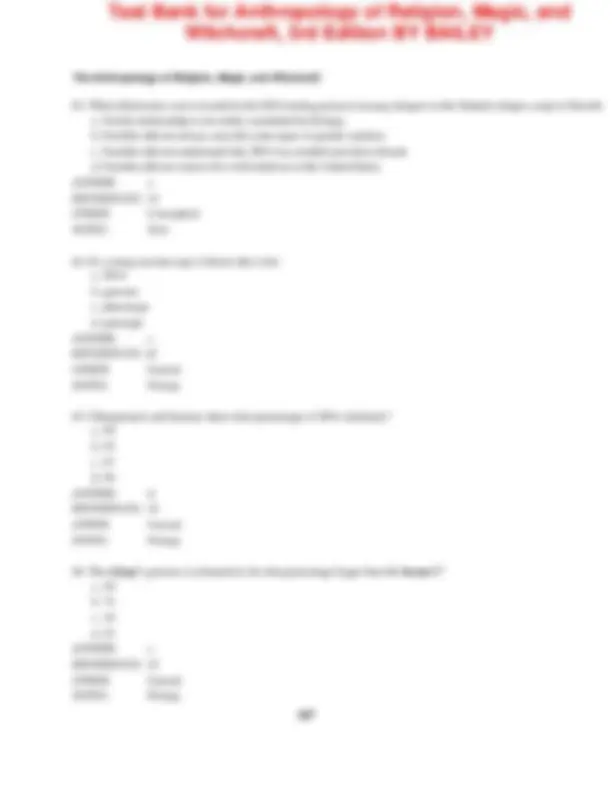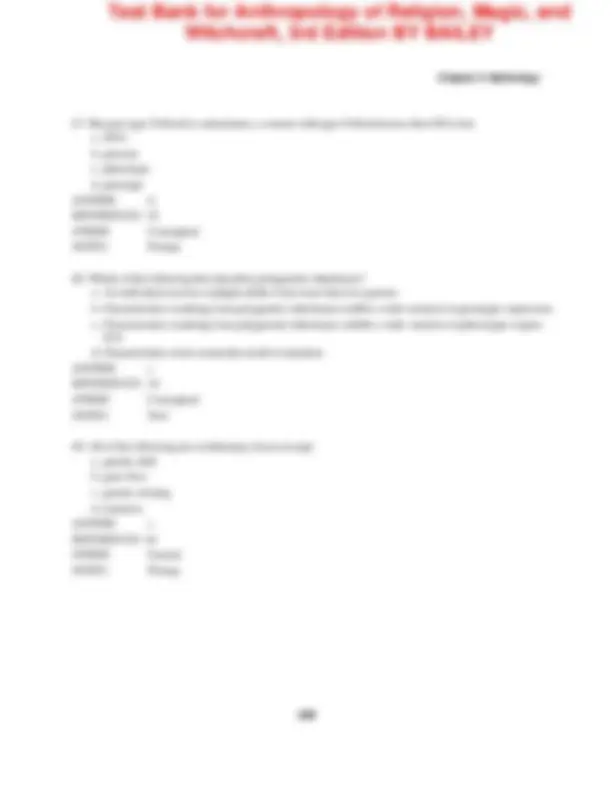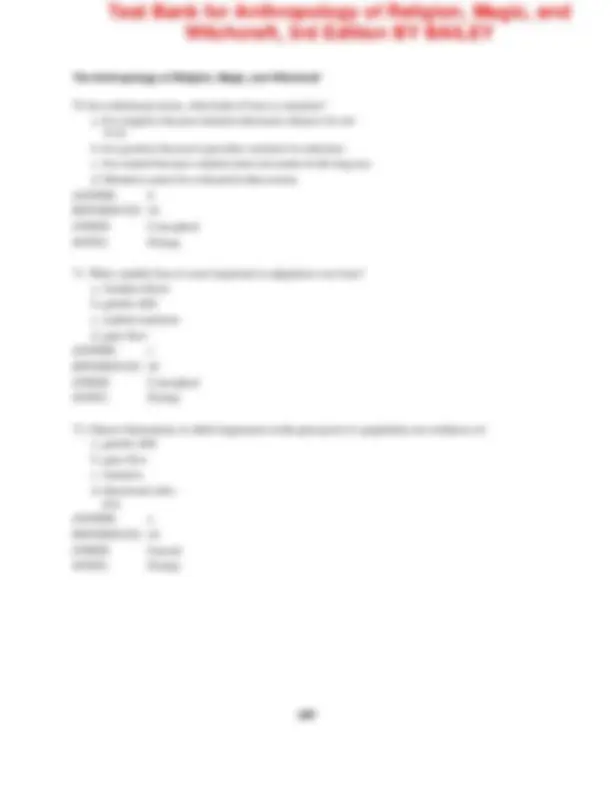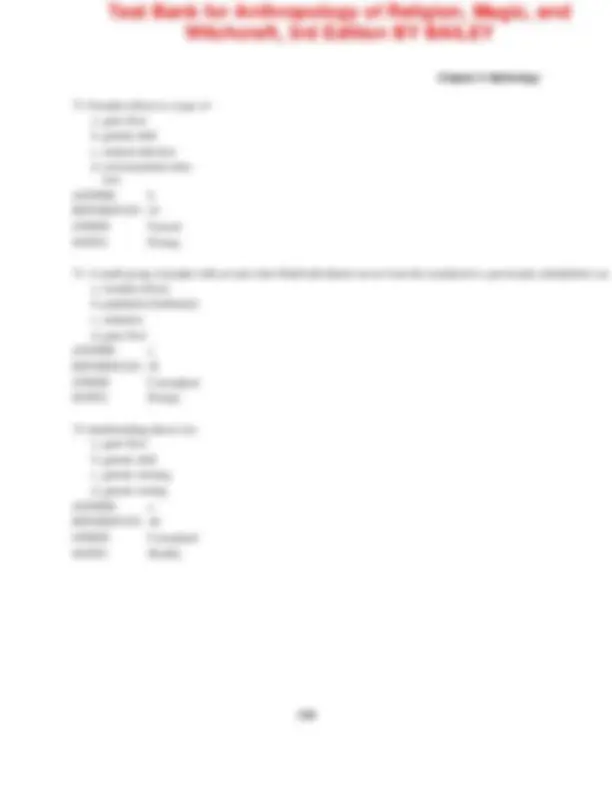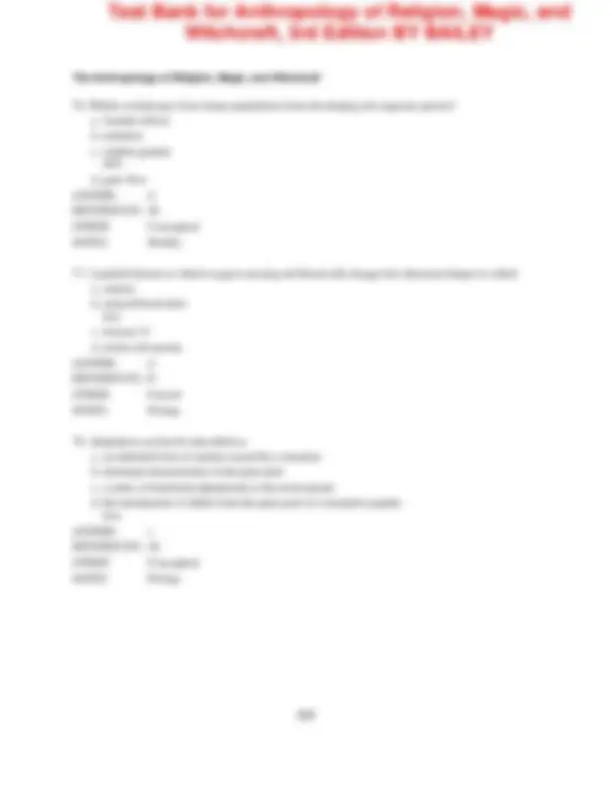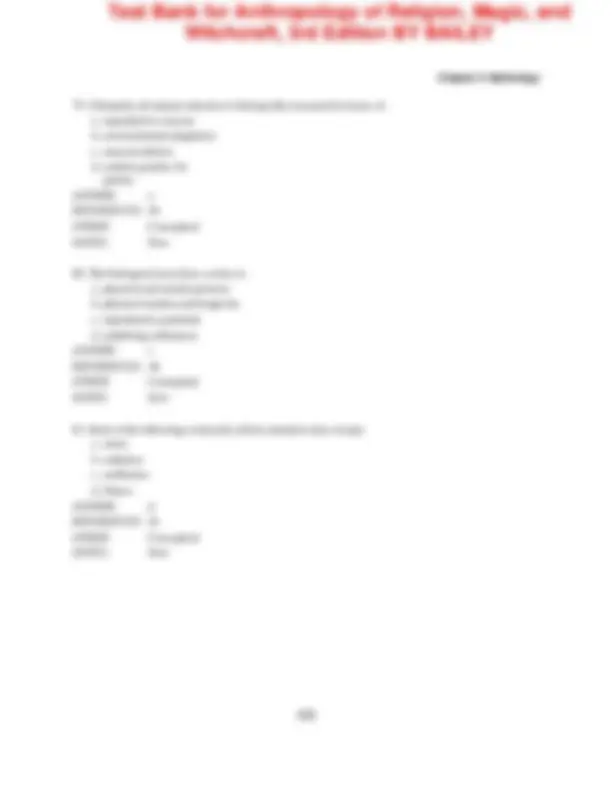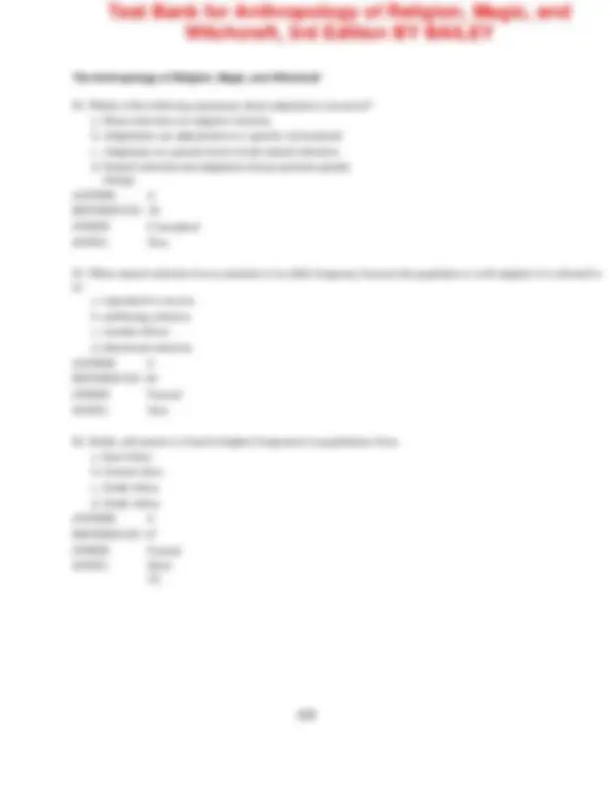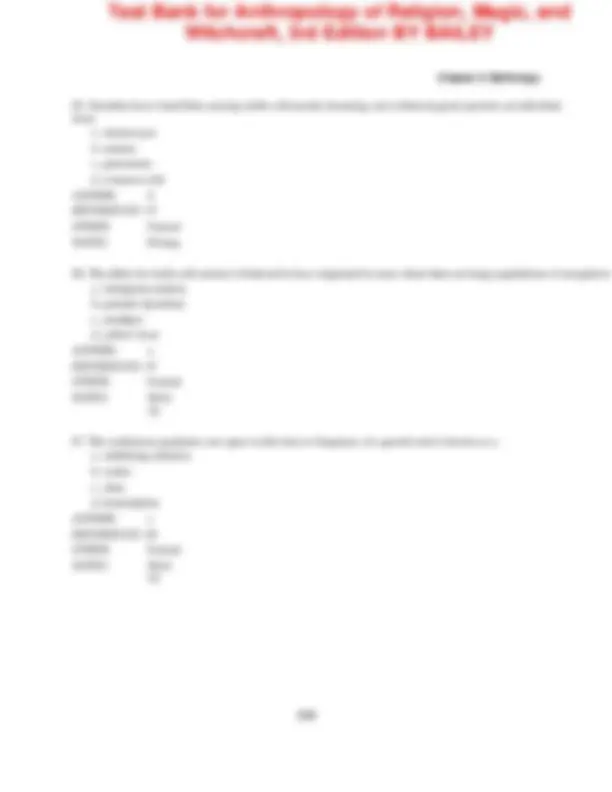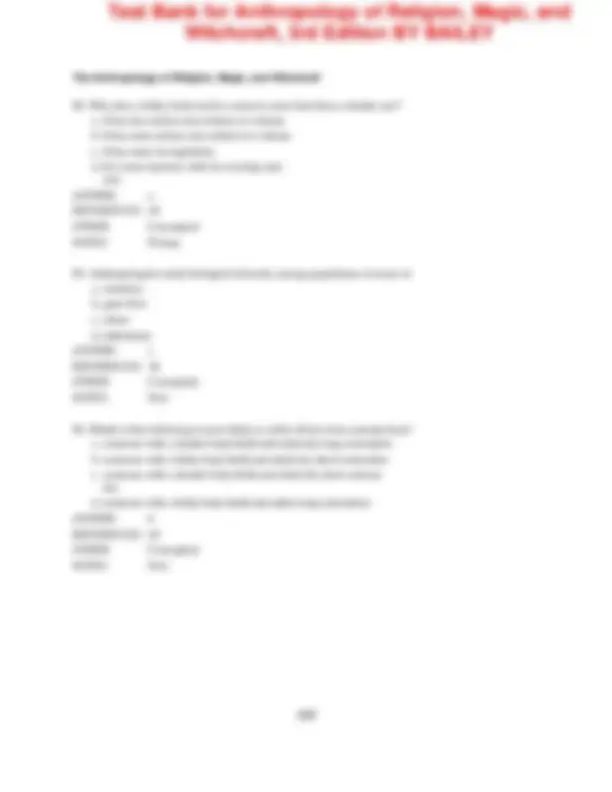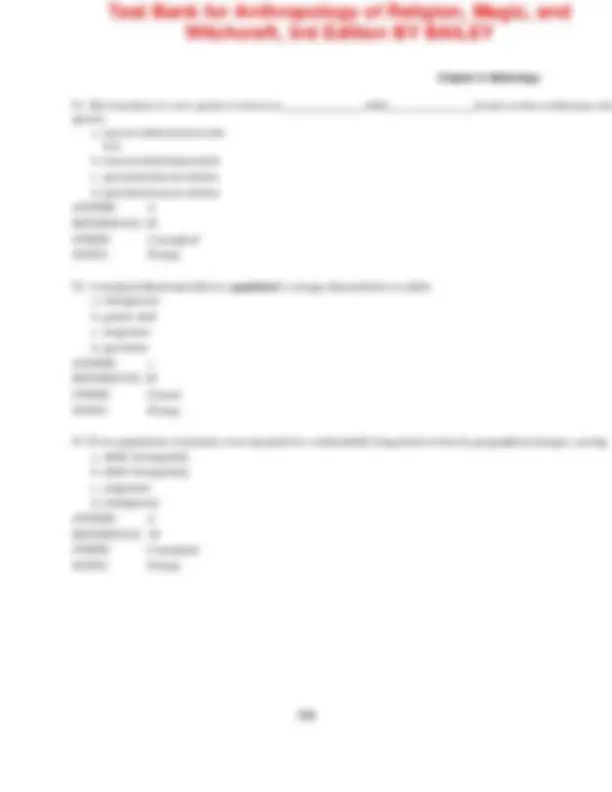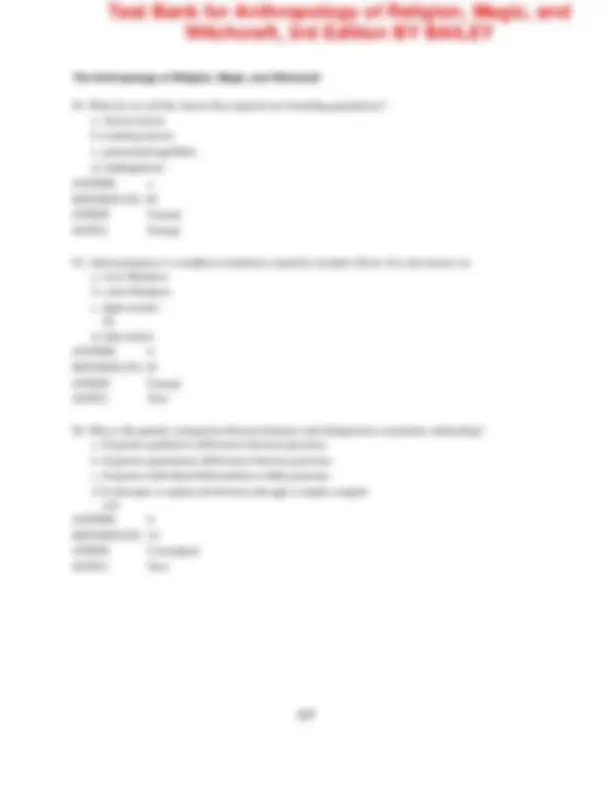Download Test Bank for Anthropology of Religion, Magic, and Witchcraft, 3rd Edition BY BAILEY and more Exams Anthropology of religion in PDF only on Docsity!
Witchcraft, 3rd Edition BY BAILEY
The Anthropology of Religion, Magic, and Witchcraft
Test Bank for Essentials of Cultural Anthro-
pology 3rd Edition by Bailey 2
CHAPTER 2
CULTURE
LEARNING OBJECTIVES
After reading Chapter 2, the student should be able to:
1. Describe the anthropological meaning of culture and its complexities.
2. Explain why it is usually mistaken to equate “culture” with “nation” or “society.”
3. Discuss the nonobvious components of cultural knowledge and their importance.
4. Evaluate the importance of culture to human life.
KEY TERMS
culture (22)
cultural identity (23)
subculture (23)
enculturation (socialization) (24)
patterns of behavior (26)
role (27)
Witchcraft, 3rd Edition BY BAILEY
The Anthropology of Religion, Magic, and Witchcraft
norm (27)
values (28)
symbol (30)
cultural construction (31)
world view (34)
CHAPTER SUMMARY
Anthropologists use the concept of culture to understand the diversity of human experience.
Culture is the shared, socially learned knowledge and patterns of behavior that are unique to a
group of people. Culture is not only essential for humanity, but it is also the key to our successful
adaptation in a wide variety of environments.
Though definitions vary widely, anthropologists generally agree on certain characteristics of
culture: it is learned, shared, has a profound impact on the group of people who share it, and is
central to understanding the different ways in which groups of people act, think, and feel. In a
narrow sense, culture can be defined as a mental phenomenon; material artifacts and behaviors,
for example, are products of culture in this sense. Broadly defined, culture refers to the way of
life of a given group of people and explains the distinctiveness of the group. Culture is shared by
definition, and always socially learned. Biological differences do not explain cultural differences;
they are independent of each other. Culture is passed from one generation to the next, and trans-
mitted from place to place at any given time.
Attitudes, beliefs, assumptions about the world and other socially learned information that is
stored in the mind, is called cultural knowledge. The five components of cultural knowledge are:
norms, values, symbols, constructions of reality (including the natural and social worlds), and
world views through which reality is interpreted. Culture knowledge is learned through encultur-
ation. It is necessary for human existence because it enables us to adapt to our environments and
provides the basis for human life, as well as shaping our view of reality.
LECTURE OUTLINE
CULTURE
I. A Definition of Culture
a. Culture is both a concept and a word.
b. The modern idea of culture developed in the nineteenth century.
c. All human groups possess culture to the same degree.
d. Anthropological definitions of culture share certain features.
i. Culture is learned from other people while growing up in a particular soci-
ety or group.
ii. Culture is widely shared by the members of that society or group.
Witchcraft, 3rd Edition BY BAILEY
The Anthropology of Religion, Magic, and Witchcraft
c. Cultural world views
i. A world view is the way a people interpret reality and events, including
their images of themselves and how they relate to the world around them.
1. Some cultures believe in things that others do not.
2. Most world views make a connection between the “natural” and
“supernatural.”
3. The way people view their place in nature is part of their world
view.
IV. Culture, Biology, and Human Life
a. Culture is necessary for human existence in at least three specific ways.
i. One, culture provides the knowledge we need to adapt to our surround-
ings.
ii. Two, culture is the basis for human social life.
iii. Three, culture profoundly influences our views of reality.
SUGGESTED SUPPLEMENTARY LECTURES
Culture and Hominids
Discuss how definitions of culture might or might not apply to other hominid species. Consider
the consequences of assuming only modern humans have culture and culture only exists in mod-
ern humans on Homo erectus or Australopithecus afarensis and others. Discuss the possibility
culture arose suddenly in one species or that various components of culture arose at different
times throughout prehistory.
Culture and Nonhuman Primates
Discuss the cognitive capacities of monkeys and apes. Potato washing behavior in Japanese mon-
keys is a famous example of social learning still debated. Chimpanzee mothers may exhibit
teaching their infants the correct technique for cracking open palm nuts with stone hammers.
Students are often amazed by the ability of chimpanzees to use symbols and other properties of
language. Detail the experiments done with Kanzi, the bonobo chimpanzee. One point to make is
how the results of similarities between chimpanzee or non-human primate “culture” and human
culture should not be too surprising, given the close degree of shared genetic material between
chimpanzees and humans.
The Importance of Culture
Discuss the effects of symbolic thought in humans. For example, consider how symbolic thought
helps us adapt to the environment. Since it is often stated that human cultural transmission of
adaptations occurs at a faster rate than genetic adaptations, explain the implications that human
culture transcends biological heritage. Consider if symbolic thought has reduced human biologi-
cal diversity. Illustrate how the human global distribution is unusual among animals and yet we
belong to a single species.
Witchcraft, 3rd Edition BY BAILEY
Chapter 2: Mythology
Meaning Behind Behavior
Cross-cultural misunderstandings can occur if individuals assume that any given behavior has the
same meaning universally. Provide examples of similar behaviors that might have different
meanings. One example is an affectionate pat on the head of an American child is received as
disgusting by a Balinese child. Another facet to explore is how different behaviors can have simi-
lar meanings, such as different ways to show respect. An example of this would be assuming a
sitting position in the presence of an African emir, but standing in the presence of the President
of the United States.
The Importance of Symbols
Most anthropologists agree that the human capacity to symbolize and attach arbitrary meanings
to objects, events, and so forth is what makes culture possible. Devote part of a lecture to how
the culture that humans learn, share, and experience, actually relies on the ability to understand
and interpret the world using symbols whose meanings are socially created and learned. Provide
some examples of verbal, graphic, and behavioral symbols. Engage students by encouraging
them to suggest some of their own.
MEDIA SUGGESTIONS
Characteristics of Culture, Lesson 2 of the series, Our Diverse World (2:36 minutes,
2008), streamed through Coast Learning Systems. This segment uses the city of Oax-
aca, Mexico, to explore the nature of culture and how cultures are studied. In addition to visually
defining the characteristics of culture, this segment explores how culture changes in response to
outside forces. A bio-cultural approach is also explained. Full length version available with pur-
chase. http://www.coastlearning.org/course-catalog/alphabetical-order/30-cultural-anthropology-
our-diverse-world.html
Culture Shock (3:53 minutes, 2008), streamed from COAST. Somali immigrants create new lives
in America but encounter challenges in language and employment, placing additional strain on
local community resources.
http://college.cengage.com/anthropology/shared/videos/video23.html
Defining Race, American in Black and White , Part 1 (7:17 minutes, 2003) and Part 2
(5:11 minutes, 2003), streamed from COAST, courtesy of ABC News. The use of ge-
netic testing to evaluate cultural affiliation creates challenges in identity. http://college.-
cengage.com/anthropology/shared/videos/video24.html
Dead Birds (83 minutes, 1963) preview available through Documentary Educational Resources.
This classic ethnographic film depicts the life of the Dugum Dani of New Guinea prior to exten-
sive contact with the industrialized world. The practices of Dani warfare and magic are featured.
Available for purchase. http://www.der.org/films/dead-birds.html
Witchcraft, 3rd Edition BY BAILEY
Chapter 2: Mythology
2. Search the internet to locate two primate research centers located in the U.S. Explore these
websites to determine if non-human primates learn via social learning, as humans do. Note
examples that seem to demonstrate social or imitative learning. Relate your findings to the
discussion of social learning as a means of enculturation in the text. Determine if you believe
non-human primates have culture using supporting evidence and summarize your research,
including sources.
3. Use the key words “American cultural values” as search terms to locate at least one internet
site that appears trustworthy and credible and note what criteria you used to make this assess-
ment. Locate several more sites to compare descriptions of American cultural values and de-
termine in what ways they are different and if there is any consistency in how American val-
ues are defined. Make a list of the values and evaluate each based on your own experience.
Values are important to the maintenance of culture. Note significant differences and reflect
on societal impact. Summarize your ideas and sources for class discussion.
4. Conduct an internet search using the keywords “family” and “values,” along with various ge-
ographical areas (e.g. Africa) to prepare a cross-cultural comparison of family values and
their influences. Note values that seem different from and similar to your own. Prepare notes
and a works cited page, and be prepared to discuss your findings in class.
5. Conduct an internet search using the keywords “culture” and “biology.” Screen results to find
those relating to anthropology and develop several examples of the relationship between cul-
ture and biology in some aspect of human life. Cite your sources.
6. Instruct students to search for information regarding which animals other than humans
demonstrate cultural behavior. Use the keywords, “culture” and “animal” to see if you can
find evidentiary examples. Review search results and assess if the term culture is used differ-
ently when applied to other animals. Provide examples of animal behavior that might indi-
cate the presence of culture. Summarize your findings to present to class and cite sources.
7. Explore the evolution of culture using the key words “evolution” and “culture.” Describe at
least one view of how culture has evolved in humans. Explain what factors are involved in
the evolution of culture and which species of early humans evidenced such behavior. Prepare
a summary of your research, including a works cited page.
Witchcraft, 3rd Edition BY BAILEY
TEST BANK FOR INTRODUCTION TO PHYSI-
CAL ANTHROPOLOGY 2013 2014
EDITION 14TH EDITION BY JURMAIN
CONTACT US AT
WHISPERHILLS@GMAIL.COM
The Anthropology of Religion, Magic, and Witchcraft
CHAPTER 2: THE DEVELOPMENT OF EVOLUTIONARY THEORY
Chapter Outline
I. Introduction a) Evolution is often denigrated as being “only” a theory. i) Evolution is, in fact, a scientific theory that has a wealth of support, and is the unifying theory of the biological sciences. b) Evolution is of central importance to physical anthropology, and evolutionary thought has had a long history of development. i) The earliest human ancestors evolved from a species that lived some 6 to 8 million years ago. ii) All living species are the current result of processes that go back millions of year. iii) We see microevolutionary changes in many species including humans. iv) Some religious views hold that evolutionary statements run counter to biblical teachings. II. A Brief History of Evolutionary Thought a) The discovery of evolutionary principles date back to the sixteen century. b) Charles Darwin was the first person to explain the basic mechanics of the evolutionary process, although Alfred Russel Wallace independently duplicated Darwin’s ideas. c) Just as technological change is based on past achievements, scientific knowledge builds on previ- ously developed theories. d) The predominant European worldview throughout the Middle Ages was one of stasis and the fix- ity of the species. i) Christian teachings that God created all life were taken literally. ii) The universe was perceived as being part of the Grand Design. (1) Archbishop James Ussher calculated that the world had been created in 4004 B.C.
Witchcraft, 3rd Edition BY BAILEY
The Anthropology of Religion, Magic, and Witchcraft
(1) He noted that population sizes increase exponentially but food supplies remain stable. (a) This concept inspired both Charles Darwin and Alfred Wallace. viii) Charles Lyell (1797-1875), author of Principles of Geology (1830-1833), is considered the founder of modern geology. (1) He demonstrated that uniform processes (uniformitarianism) could account for present geological features. (2) His ideas provided the time depth necessary for biological evolution to have occurred. ix) Alfred Russel Wallace (1823-1913) developed his own theory of natural selection after collecting bird and insect specimens in Southeast Asia. (1) He first published some of his ideas in 1855, and then in 1858 Wallace wrote “On the Tendency of Varieties to Depart Indefinitely from the Original Type”. x) Mary Anning (1799-1847), an amateur geologist and famous “fossilist”, unknowingly contributed significantly to the field of paleontology by discovering hundreds of fossils in- cluding the first complete fossil of an Ichthyosaurus. III. The Discovery of Natural Selection a) Charles Darwin (1809-1882) proposed the first credible mechanism for evolutionary change, nat- ural selection, in On the Origin of the Species (1859). i) After graduating from Christ’s College, where he studied theology, but also cultivated his interests in natural science and geology, he was recommended to join the five-year expedition of the HMS Beagle. (1) Darwin began the voyage as a believer in the fixity of species, but his observations of, among other things, fossils of giant ancient versions of living animals and varieties of Galápagos finches eventually convinced him to the contrary. (2) After his return to England in October 1836, he began to formulate his theory of natural selection. (a) He wrote summaries of his ideas in 1842 and 1844, but felt he needed more evidence before he published. (b) He was sent both of Wallace’s papers, and Darwin was spurred to put all of his ideas in writing. (c) Initial reaction to On the Origin of Species was mostly negative, but scientific opin- ion gradually shifted to Darwin’s favor. b) In Darwin’s Shadow unlike Darwin, Alfred Russell Wallace was born to a family of modest means. i) In 1855 Wallace an article suggesting that current species were descendant of older species and that the appearance of new ones were influenced environmental factors played a role in their evolution. (1) This article caused Lyell and others to urge Darwin to publish his findings but he contin- ued to hesitate. (2) In 1858 Wallace sent Darwin another paper, the title was “On the tendency of varieties to depart indefinitely from the original type” where he described evolution as a process driven by competition in natural selection. (3) Darwin realized that unless he published his work, Wallace would get credit for the the- ory he had been working on for many years. In December 1859, Darwin completed and published his greatest work “On the Origin of Species.” IV. Natural Selection a) Darwin envisioned it as a process in which individuals with favorable variations survive and re- produce at a higher rate than those with unfavorable variations. The key elements in Darwin’s formulation include:
Witchcraft, 3rd Edition BY BAILEY
Chapter 2: Mythology
i) The potential for reproductive rates that outpace the rate of increase of food supplies. ii) The presence of biological variation within all species. iii) Constant competition among individuals for survival. iv) Individuals with favorable traits are more likely to survive and reproduce. v) The environment “determines” which traits are favorable. vi) Favorable traits are passed on to offspring at a higher rate than non-favorable traits, thus increasing in frequency through time and eventually producing new species. vii) Geographical isolation may lead to the formation of new species. V. Natural Selection in Action a) Natural selection is an empirically studied phenomenon. i) Industrial melanism is a documented case of evolutionary shifts in frequencies of pig- mentation patterns in peppered moth populations near Manchester, England. (1) Evolutionary shifts in response to the environment are called adaptations. ii) Natural selection has been demonstrated on the (Galápagos) island of Daphne Major. (1) Measurements of beak thickness changes through time among the medium ground finch indicate that thicker-beaked individuals had greater reproductive success during droughts. iii) Natural selection, through the use of antibiotics, is responsible for the increased number of antibiotic-resistant strains of microorganisms. b) These examples of natural selection in action indicate that certain common principles apply: i) A trait must be inherited to have importance in natural selection. ii) Natural selection cannot occur without variation in inherited characteristics. iii) Fitness is a relative measure that will change as the environment changes. iv) Natural selection can act only on traits that affect reproduction. c) Natural selection can act through not only differential death rates, but also through differential fertility rates. VI. Constraints on Nineteenth Century Evolutionary Theory a) Darwin argued that natural selection acts on variation within species, yet no one could explain the source of this variation. b) Darwin also didn’t know how favorable traits were passed from generation to generation. i) The laws of heredity were unknown, and most believed that parental traits were blended in the offspring. ii) Gregor Mendel had worked out the modern principles of heredity, but his work was not recognized until the beginning of the 20th^ century. VII. Opposition to Evolution Today a) Darwin’s formulation of evolution was offensive to Christians because it was in conflict with bib- lical versions of the creation. b) The debate over evolution is far from over, especially in the U.S. and increasingly in several Mus- lim countries. c) The mechanisms of evolution are complex, and many people do not understand them. i) Many are not comfortable with the principles of biology and genetics and have little sci- entific background. ii) Most Americans are raised in belief systems that do not emphasize the biological continu- ity between life forms. d) Yet, evolutionary theories are accepted, in part, by the Catholic Church and most mainstream Protestants. e) A Brief History of Opposition to Evolution in the United States reveals why most fundamen- talists reject all scientific explanations of evolution.
Witchcraft, 3rd Edition BY BAILEY
Chapter 2: Mythology
Student Activities
Activities and Assignments
- Visit PBS Evolution website and watch some of the videos related to Darwin and then practice with some of the web exercises available at (http://www.pbs.org/wgbh/evolution/darwin/index.html)
- From Jurmain et al. Basic Genetics for Anthropology CD: Have students go through section I, Evo- lution and Natural Selection , and complete the quiz.
- From J. Kappelman’s Virtual Laboratories for Physical Anthropology CD: Students should complete Section I of Lab 2 : Evolution and Natural Selection to reinforce their conceptual understanding of natural selection. From Jurmain et al. Basic Genetics for Anthropology CD: Use the animations of evolution and natural selection to introduce these concepts for your lecture.
- Use the Anthropology Resource Center and use the resources available there, including the Video Exercises on Natural Selection (www.cengagebrain.com).
- Learn more about the complex person Charles Darwin was by watching one of the following films, many of these are available free at www.topdocumentaryfilms.com A. http://topdocumentaryfilms.com/charles-darwin-tree-life/ B. http://topdocumentaryfilms.com/darwins-dangerous-idea/ C. http://topdocumentaryfilms.com/darwins-secret-notebooks/ D. http://topdocumentaryfilms.com/darwin-struggle-evolution-origin-species/ E. The video Charles Darwin: Evolution’s Voice from A & E’s Biography series is particu- larly relevant.
Media Suggestions
- The Discovery Channel has a series of short scientific video clips which explain the processes of evolution, available at http://topdocumentaryfilms.com/100-greatest-discoveries-origins-and-evolu- tion/
- Visit the National Center for Science Education’s website, http://www.ncseweb.org/, and read about creationist attempts to teach “creation science” in public schools. First click on “Links” and then the “Critiques of Creationism” link and write a paragraph summarizing one of the critiques.
- One historical figure that vehemently opposed Darwin’s ideas was Louis Agassiz (1807-1873). Go to the University of California - Berkeley’s Museum of Paleontology website for information on Agassiz (http://www.ucmp.berkeley.edu/history/agassiz.html) and write a brief paragraph on his life and ideas.
- Visit Berkeley’s website on Evolution (http://www.ucmp.berkeley.edu/history/evolution.html)
Multiple Choice Questions
- In Europe during the Middle Ages, it was believed that a. all species had evolved from a common ancestor. b. evolution was the result of natural selection acting upon genetic variation. c. all forms were created by God and did not change over time. d. most species had become extinct over time.
Witchcraft, 3rd Edition BY BAILEY
The Anthropology of Religion, Magic, and Witchcraft
e. life was created slowly, over millions of years.
ANS: C REF: 26 DIF: Factual OBJ: 5 MSC: Pickup
- The belief that species do not change but are the same as when first created is known as a. fixity of species. b. the Great Chain of Being. c. heliocentric. d. uniformitarianism. e. natural selections.
ANS: A REF: 27 DIF: Factual OBJ: 5 MSC: Pickup
- Just as technological change is based on past achievements, scientific knowledge builds on previ- ously developed a. hypothesis. b. ideas. c. technology. d. theories. e. beliefs.
ANS: D REF: 26 DIF: Factual OBJ: 5 MSC: New
- The plan of the entire universe was viewed as a. the binomial system. b. natural selection. c. uniformitarianism. d. God’s design. e. Lamarckism.
ANS: D REF: 27 DIF: Factual OBJ: 5 MSC: Pickup
- How did the discovery of the Americas (New World) impact European understanding of biological diversity? A. It exposed them to plants and animals they had never seen. B. It proved the validity of biblical texts. C. It demonstrated fixity of species. D. It supported standing notions of the Great Chain of Beings. E. It had no impact on notions of biological diversity.
ANS: A REF: 28 DIF: Factual OBJ: 1 MSC: New
- The fact that anatomical structures appear to be uniquely fitted to the functions they serve was the basis for the a. theory of uniformitarianism. b. theory of natural selection. c. theory of the inheritance of acquired characteristics.
Witchcraft, 3rd Edition BY BAILEY
The Anthropology of Religion, Magic, and Witchcraft
b. Georges-Louis Leclerc de Buffon c. Erasmus Darwin d. John Ray e. Georges Cuvier
ANS: B REF: 29 DIF: Factual OBJ: 1 MSC: Pickup
- Which naturalist attempted to explain the evolutionary process by suggesting a dynamic relationship between species and the environment? a. Jean Baptiste Lamarck. b. Erasmus Darwin. c. Georges-Louis Leclerc de Buffon. d. Galileo Galilei. e. Charles Lyell.
ANS: A REF: 30 DIF: Factual OBJ: 1 MSC: New
- Who was the first to offer a scientific explanation for how species changed? a. Carolus Linnaeus b. Jean-Baptiste Lamarck c. Charles Lyell d. Charles Darwin e. Erasmus Darwin
ANS: B REF: 30 DIF: Factual OBJ: 1 MSC: Pickup
- The theory that the frequent use of an organ caused it to be enhanced was developed by a. Charles Darwin. b. Carolus Linnaeus. c. Georges Cuvier. d. Charles Lyell. e. Jean-Baptiste Lamarck.
ANS: E REF: 30 DIF: Factual OBJ: 1 MSC: Pickup
- The role of the environment as a significant factor in evolutionary change was first recognized and stated by a. Jean-Baptiste Lamarck. b. Georges Cuvier. c. Thomas Malthus. d. Charles Darwin. e. Charles Lyell.
ANS: A REF: 30 DIF: Factual OBJ: 1 MSC: Pickup
- The term “biology” was coined by
Witchcraft, 3rd Edition BY BAILEY
Chapter 2: Mythology
a. Jean-Baptiste Lamarck. b. Georges Cuvier. c. Thomas Malthus. d. Charles Darwin. e. Charles Lyell.
ANS: C REF: 30 DIF: Factual OBJ: 2 MSC: Pickup
- The theory that characteristics acquired during the lifetime of an individual could be passed on to that individual’s offspring is termed a. natural selection. b. catastrophism. c. the inheritance of acquired characteristics. d. uniformitarianism. e. fixity of species.
ANS: C REF: 30 DIF: Factual OBJ: 1 & 2 MSC: Pickup
- The view that the extinction and the subsequent appearance of more modern forms could be ex- plained by a series of disasters and creations is known as a. natural selection. b. catastrophism. c. use-disuse theory. d. uniformitarianism. e. descent with modification.
ANS: B REF: 30 DIF: Factual OBJ: 1 & 2 MSC: Pickup
- The opponent of Jean-Baptiste Lamarck who proposed the theory of catastrophism was a. Charles Lyell. b. Alfred Russel Wallace. c. Thomas Malthus. d. Erasmus Darwin. e. Georges Cuvier.
ANS: E REF: 30 DIF: Factual OBJ: 1 & 2 MSC: Pickup
- Thomas Malthus a. proposed that population size is kept in check by the limited availability of resources. b. wrote the theory of catastrophism c. wrote the theory of uniformitarianism d. had no influence on the development of Darwin’s and Wallace’s theories of natural selection. e. was a 16th century mathematician
ANS: A REF: 31 DIF: Factual OBJ: 1 MSC: New
Witchcraft, 3rd Edition BY BAILEY
Chapter 2: Mythology
- Charles Darwin a. grew up in modest circumstances. b. began to doubt the fixity of species during a voyage around the world in the 1830s. c. received no formal education. d. spent two years in Africa where he developed the theory of natural selection. e. was a physician who studied natural history as a hobby.
ANS: BREF: 34-35 DIF: Factual OBJ: 1 & 2 MSC: Pickup
- Although Darwin went aboard the HMS Beagle believing on the fixity of species, what discovery changed his beliefs? a. the people he met on the ship. b. the discovery of fossils of ancient giant animals similar to contemporary species. c. the distance from church and society. d. the death of his child. e. the discovery of savages which looked more like apes.
ANS: B REF: 34 DIF: Factual OBJ: 1 MSC: New
- Charles Darwin a. was reluctant to publish his theories. b. wrote his theory of natural selection while still on board the Beagle. c. published his theories as soon as he returned from his voyage on the Beagle. d. was not concerned with public opinion and did not mind if his theories were criticized. e. knew his friends and colleagues would not be affected by the publication of his theory.
ANS: A REF: 37 DIF: Factual OBJ: 1 MSC: Pickup
- Which contemporary of Charles Darwin also developed a theory of evolution by means of natural se- lection? a. Charles Lyell b. Jean-Baptiste Lamarck c. Erasmus Darwin d. Alfred Russel Wallace e. Georges Cuvier
ANS: D REF: 37 DIF: Factual OBJ: 1 & 2 MSC: Pickup
- The fact that individuals who possess favorable traits are more likely to survive and reproduce than those who possess less favorable traits is the basis for the theory of a. uniformitarianism. b. natural selection. c. the inheritance of acquired characteristics.
Witchcraft, 3rd Edition BY BAILEY
The Anthropology of Religion, Magic, and Witchcraft
d. catastrophism. e. the fixity of species.
ANS: B REF: 36 DIF: Factual OBJ: 3 MSC: Pickup
- Which of the following concepts DID NOT influence Darwin in developing his theory of evolution? a. Population size increases more rapidly than food supplies. b. There is competition among individuals for resources. c. Species are unchanging types, and individual variation within a species is not important. d. There is biological variation in all members of a species. e. Favorable variations are passed on and accumulate in populations over time.
ANS: C REF: 35-36 DIF: Factual OBJ: 1 & 3 MSC: Pickup
- Which species in the Galapagos islands was fundamental to Darwin’s evolutionary ideas? a. The boobies b. The seals c. The tortoises d. The finches e. The iguanas
ANS: D REF: 35-36 DIF: Factual OBJ: 1 & 3 MSC: New
- Selective pressures A. remain constant, regardless of the environment. B. are unimportant in the evolutionary process. C. can change if environmental conditions change. D. are directionless and random. E. are not related to adaptation.
ANS: C REF: 39 DIF: Factual OBJ: 2 MSC: Pickup
- “Fitness”, in an evolutionary sense, refers to an individual’s a. strength. b. reproductive success. c. aggressiveness. d. size. e. age at death.
ANS: B REF: 39 DIF: Factual OBJ: 4 MSC: Pickup
- Which of the following is true about Alfred Russel Wallace? a. He was born into a very wealthy family. b. He joined expeditions to the Amazon and Southeast Asia. c. He was a very close friend of Charles Lyell.

